On our first trip to Oaxaca City, we did as many mezcal tastings as our livers would permit to find the top mezcalerias in Oaxaca. Like anyone who enjoys a good stiff drink, we enjoyed hopping from one mezcal bar to the next, but it wasn’t enough.
Mezcal has become my favorite spirit so I wanted to learn more. I wanted to visit a mezcal distillery and the best way to do that in Oaxaca was to join a mezcal tour.
Many mezcal tours are actually sightseeing tours that make a stop at just one mezcal distillery. Thankfully, I found this one that took us to three mezcal distilleries and nowhere else.
If you enjoy Oaxacan mezcal as much as I do and would like to learn more about the mezcal making process, then you’ll probably want to book this tour.
Save This on Pinterest!
No time to read about this mezcal tour in Oaxaca? Click on the save button and pin it for later!
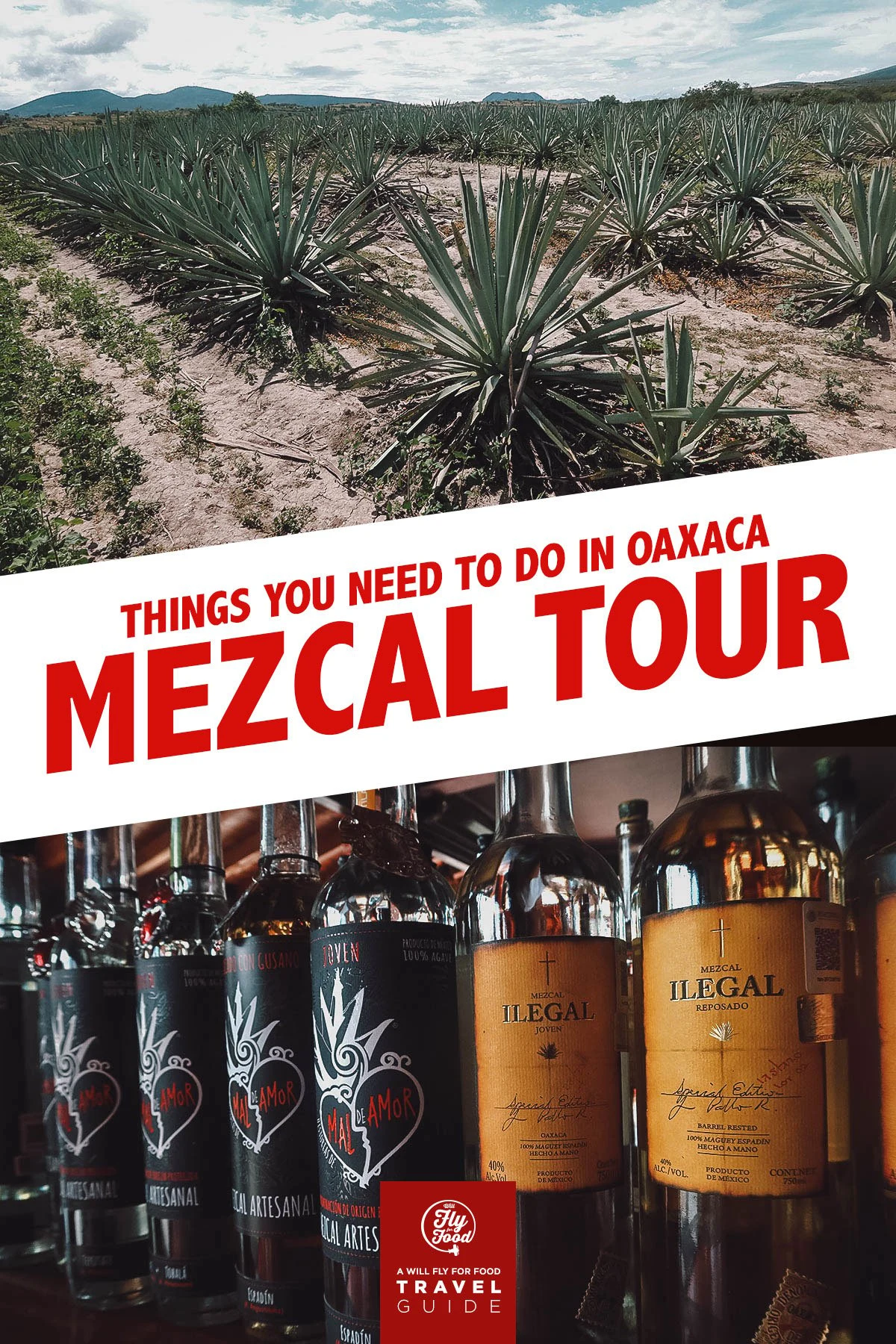
WHAT IS MEZCAL?
I cover this in our mezcaleria guide so I won’t get into it in too much detail here, but mezcal is a distilled beverage produced from the maguey (agave) plant.
Known for its smoky flavor, the state of Oaxaca accounts for over 70% of the total mezcal production in Mexico. To say that this agave spirit is an important part of Oaxacan culture and its economy would be an understatement.
If you’d like to learn more about mezcal – how it differs from tequila, its different types, where to go for mezcal tasting in Oaxaca City, etc – then be sure to check out our guide to the top mezcalerias in Oaxaca.
WHY SHOULD YOU JOIN A MEZCAL TOUR?
We learned a lot by doing mezcal tastings in Oaxaca. The bartenders in Oaxaca City are knowledgeable and many speak fluent English so understanding them was easy. They’ll give you a crash course on the different types of agave and mezcal and how to properly enjoy it, but that’s about all they can show you.
If you really want to learn about the mezcal making process and see it for yourself, then it’s best to go on mezcal educational tours. Personally, I wanted to visit as many mezcal distilleries as I could so I could see the process of making mezcal from up close.
I’ll give you an account of the tour we went on (which was awesome), but you can refer to the list below for some of the best mezcal tours in Oaxaca.
MEZCAL TOURS IN OAXACA
Listed below are the top Oaxaca mezcal tours I could find on Get Your Guide. As previously described, the majority of tours are sightseeing tours that stop at one or two mezcal distilleries. If that’s what you want, then you’ll have several to choose from.
I wanted a mezcal distillery tour that was focused only on the agave spirit and nothing else so I booked the Mezcal Adventure tour. As you can see from the prices below, it’s the most expensive tour on this list but in my opinion, it’s absolutely worth it. You can click on the links for more information about each tour.
| Name of Tour | Price (USD) | Duration |
| 1. Mezcal Adventure | $90.23 | 7 hrs |
| 2. Mezcal Tasting Session With an Expert | $53.58 | 1.5 hrs |
| 3. Mixology Workshop With Organic Mezcal | $56.39 | 2 hrs |
| 4. El Tule, Mitla, and Hierve el Agua Tour With Mezcal | $53.58 | 10 hrs |
| 5. Hierve el Agua Waterfalls and Mezcal Tasting | $67.62 | 9 hrs |
| 6. Oaxaca, Mitla, and Mezcal Factory Tour | $37.16 | 8 hrs |
| 7. El Tule, Teotitlan Village, and Mezcal Tour | $53.58 | 4.5 hrs |
| 8. Full-Day Tour Hierve el Agua Falls and Mezcal Tasting | $53.58 | 8 hrs |
OAXACA: MEZCAL ADVENTURE
Before we get into it, let’s answer a few general questions some of you may have about this Mezcal Adventure tour.
Is There Mezcal Tasting on This Tour?
Yes, absolutely! They didn’t give us just a few sips either. They gave us enough to make us happy, especially at the first distillery, which is part of the reason why I think this is the best Oaxaca mezcal tour you can book on Get Your Guide.
How Many Mezcal Distilleries Will I Visit on This Tour?
Three. You’ll visit three distilleries of varying sizes.
How Long is This Mezcal Tour and How Much Does it Cost?
At the time of this writing, the Mezcal Adventure tour costs USD 90.23 per person. Our tour lasted a little over 7 hours.
FIRST STOP: Fábrica de Mezcal Mal de Amor
After being picked up from our Airbnb, our tour guide told us we’d be visiting three distilleries of varying sizes. The first would be a large factory, followed by a medium-sized distillery, and then a small family-run operation known for their artisanal mezcal. We enjoyed them all but this first distillery in Santiago Matatlán – Fabrica de Mezcal Mal de Amor – was our hands-down favorite.
In the picture below, you can see the word “palenque” in front of the distillery’s name. Palenque is the name for a Oaxaca mezcal distillery. Other parts of Mexico have different names for mezcal distilleries like taberna, vinata, or fabrica.
Here you can see the freshly harvested hearts (piña) of the agave plant. I don’t know if you can tell how large these are but a single agave piña can weigh up to 40 kg (88 lbs).
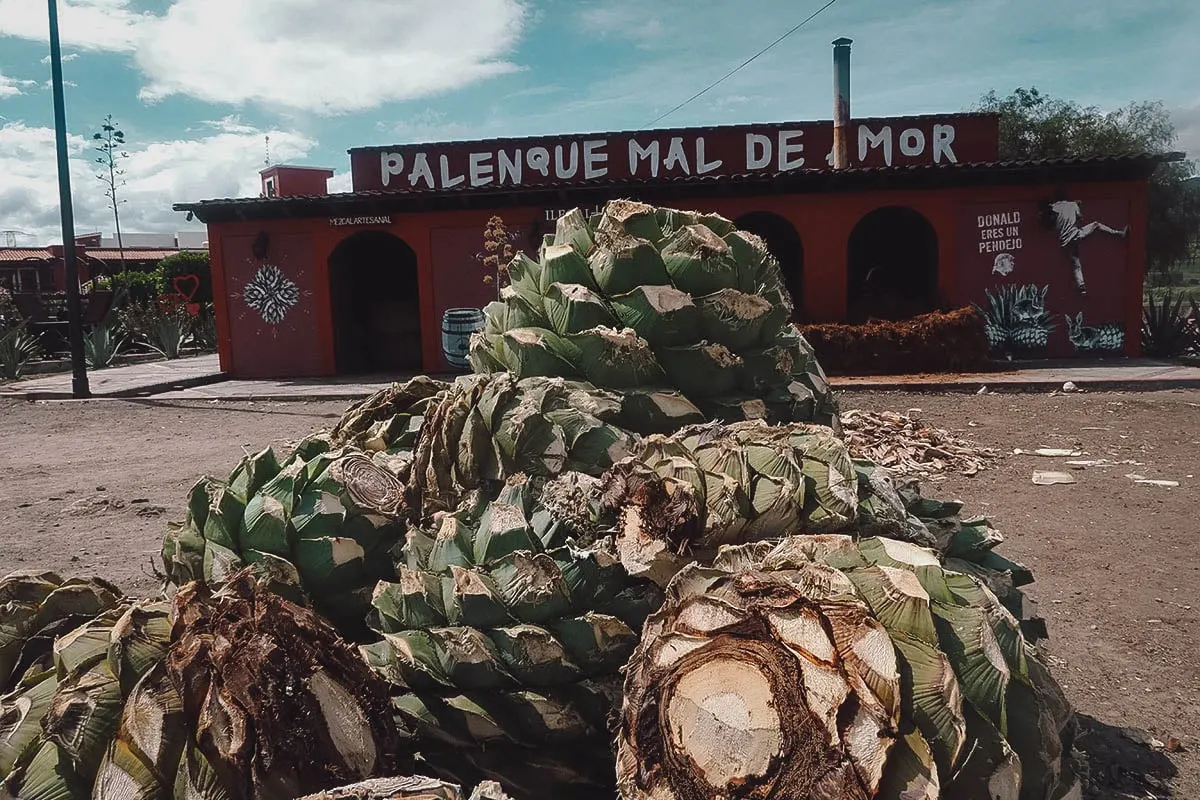
We didn’t spend much time here but pictured below is the palenque’s mezcal tasting room. Quite festive-looking isn’t it?
Those colorful paper banners are called papel picado (“perforated paper”). You’ll find them everywhere in Mexico.
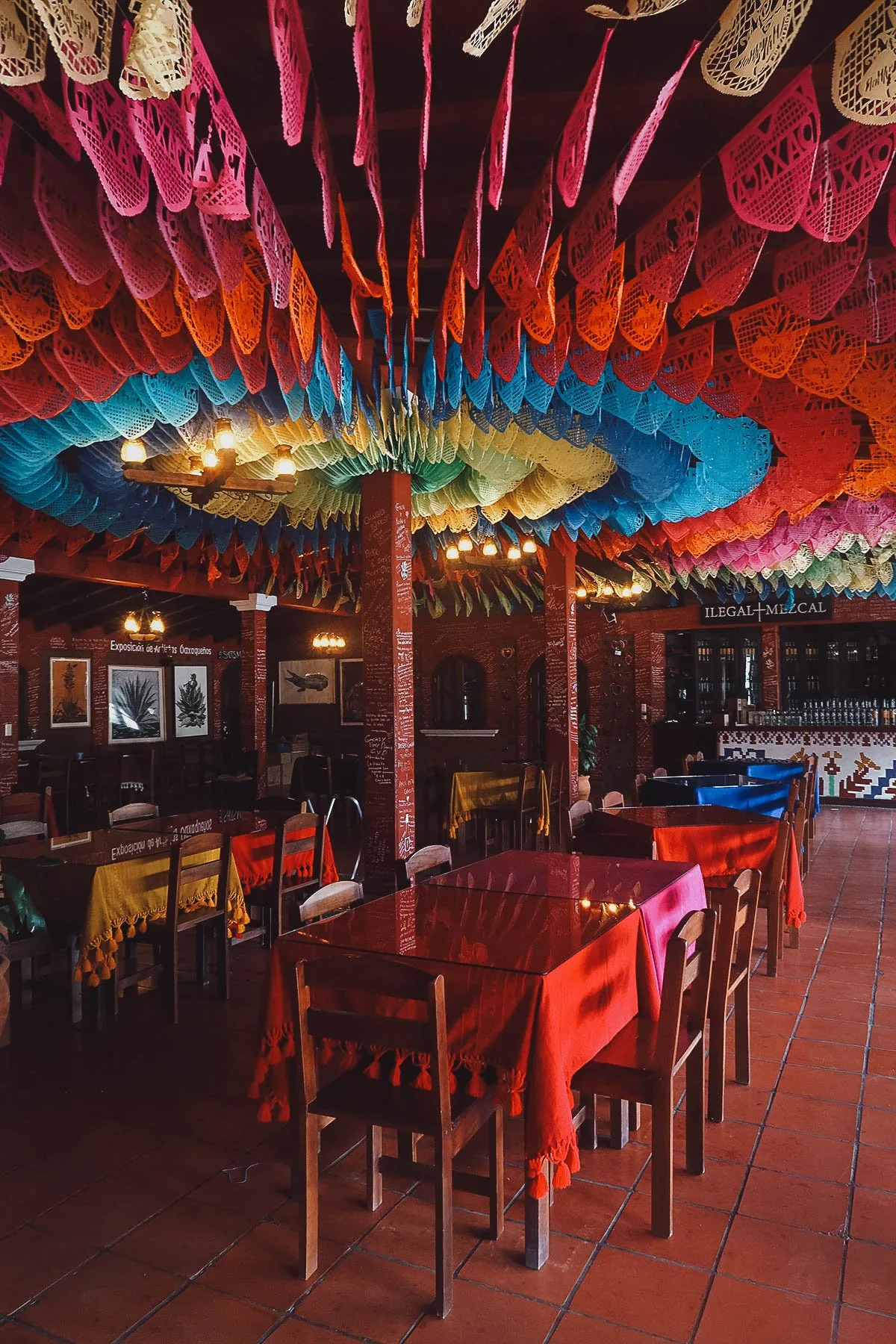
We visited Mezcalillera in downtown Oaxaca and I remember being smitten by this bottle. All of their mezcals with this label are joven, meaning they haven’t spent any time aging in oak barrels.
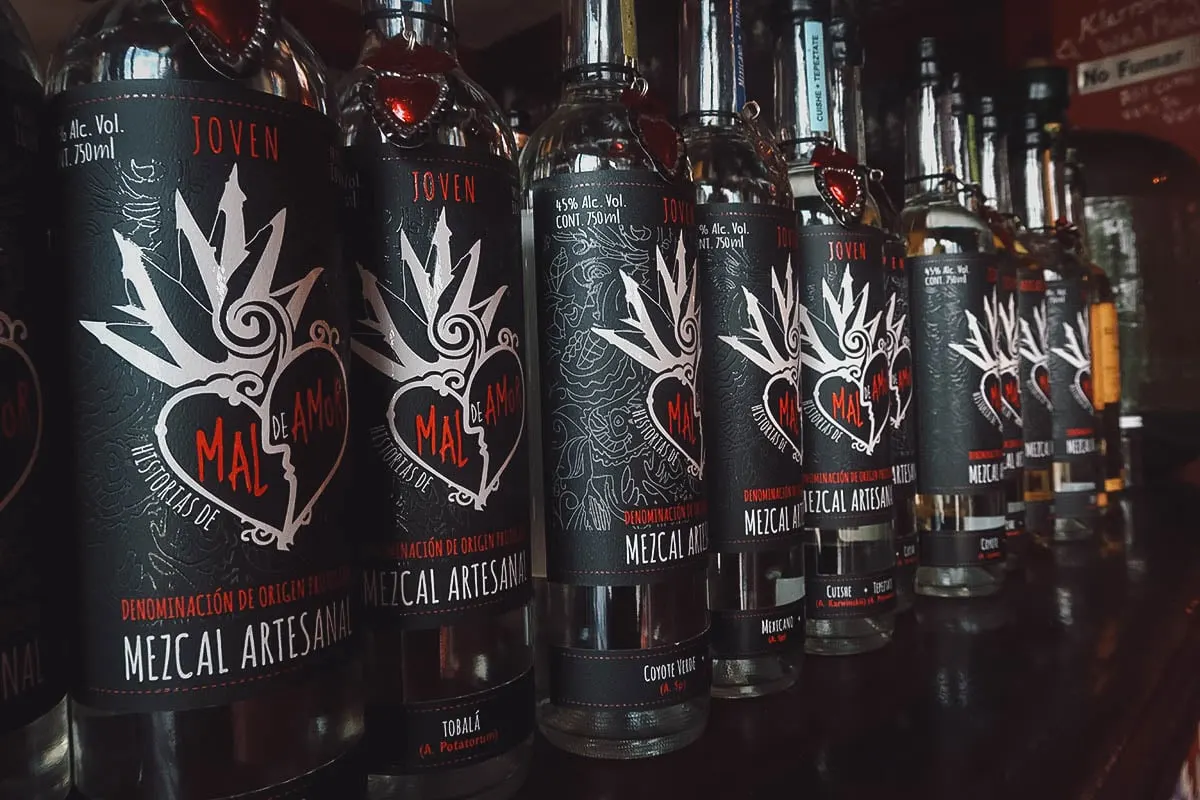
There are over 30 agave species used to make mezcal but by far the most common is maguey espadín (Agave angustifolia). This species of agave accounts for about 90% of all mezcal production in Mexico.
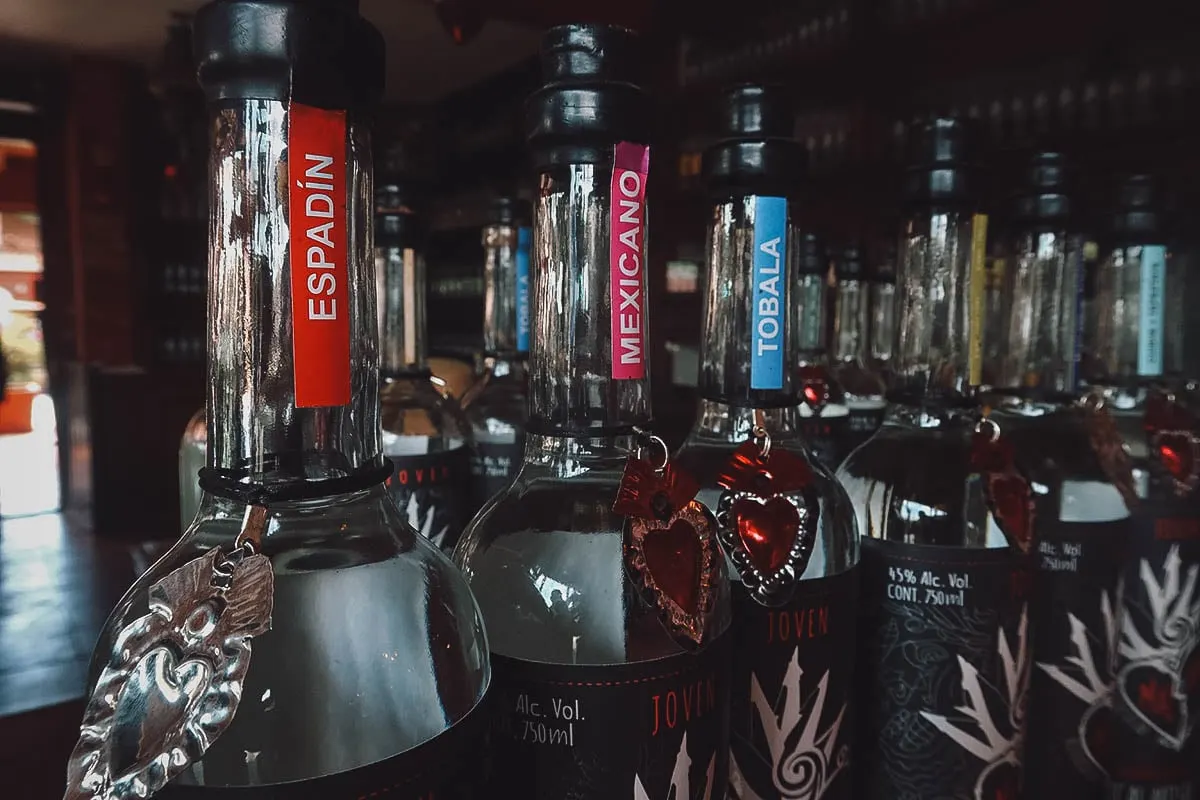
Palenque Mal de Amor is owned and operated by the Hernandez family. It’s led by Armando Hernandez, a 3rd generation mezcal master who learned the art of mezcal making from his father and grandfather.
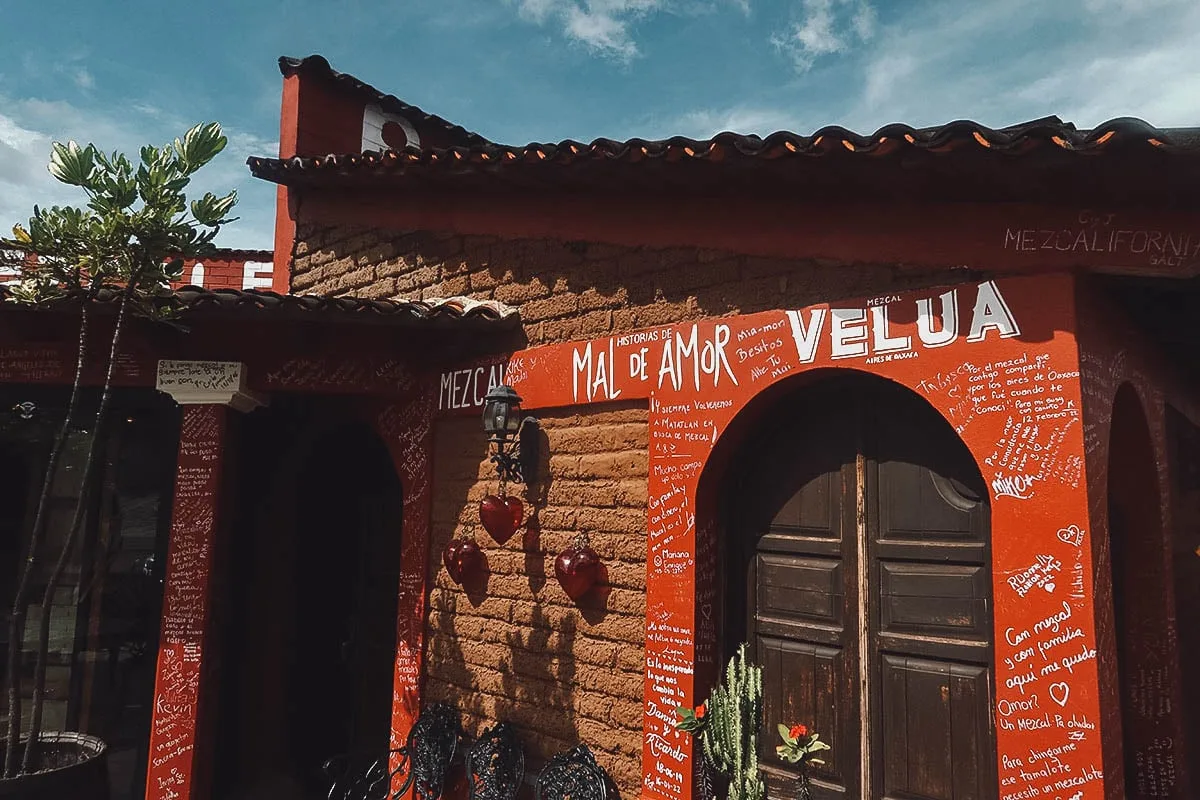
We couldn’t agree more!
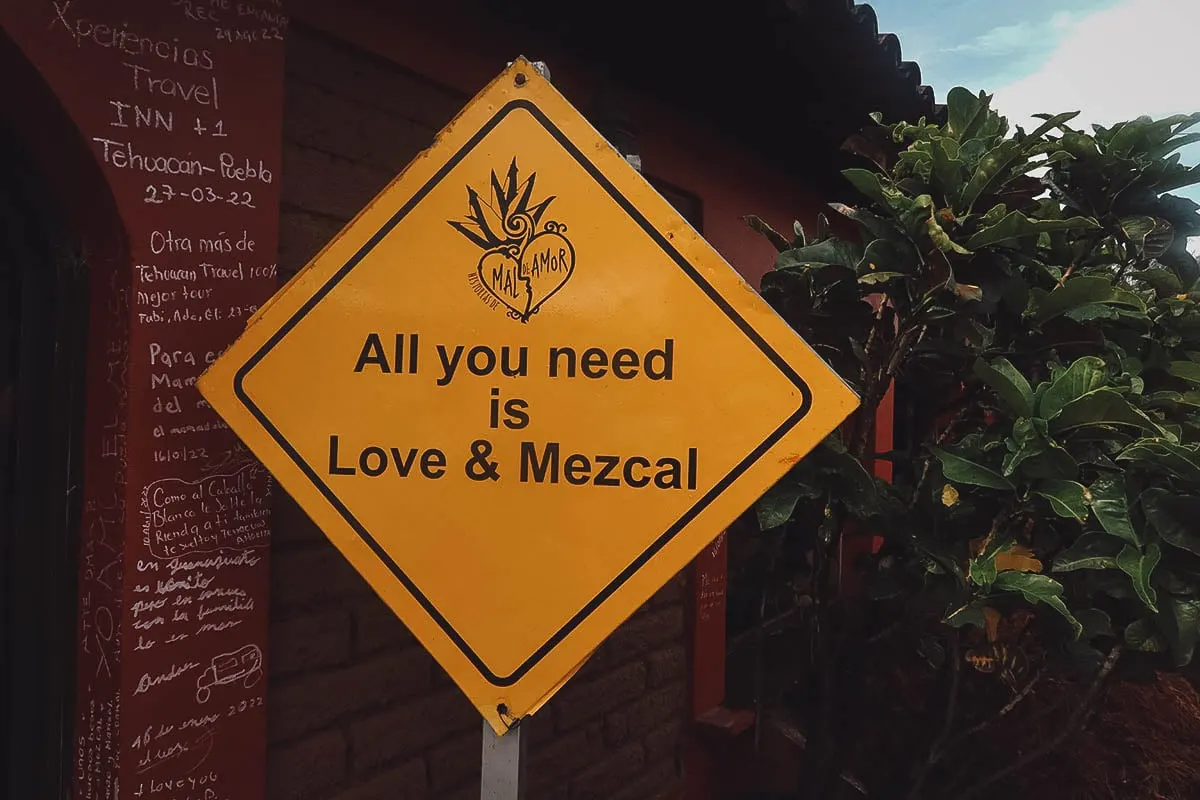
Here’s a picture of the agave plant hearts with a better sense of scale. Some of these piñas are quite massive. The mezcal process essentially starts here.
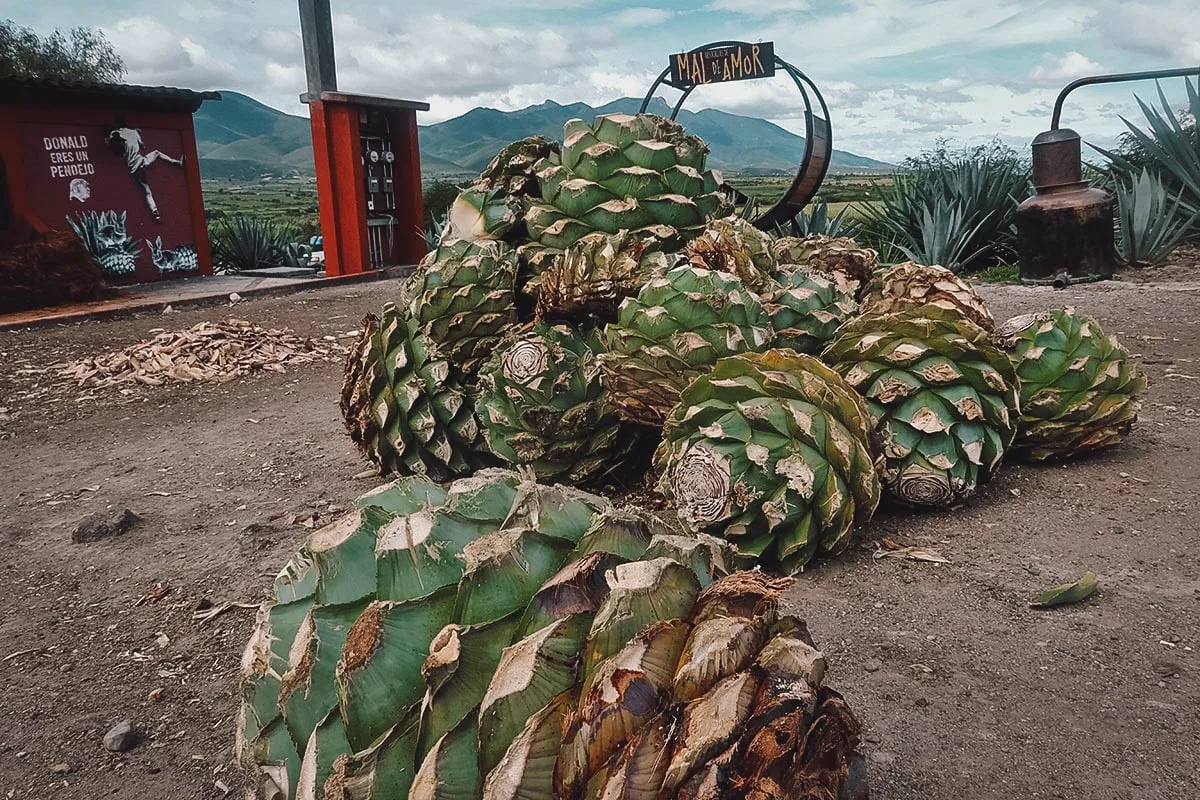
The best part of this mezcal distillery tour was coming up, but our tour guide showed us around and taught us about the various stages of mezcal production.
After harvesting, the piñas are roasted over hot rocks in these large pit ovens for about three days. This roasting process is what gives mezcal its distinctive smoky flavor (which I love).
This oven was covered and in use but you’ll see an open pit oven later in this article. The size of these ovens is impressive.
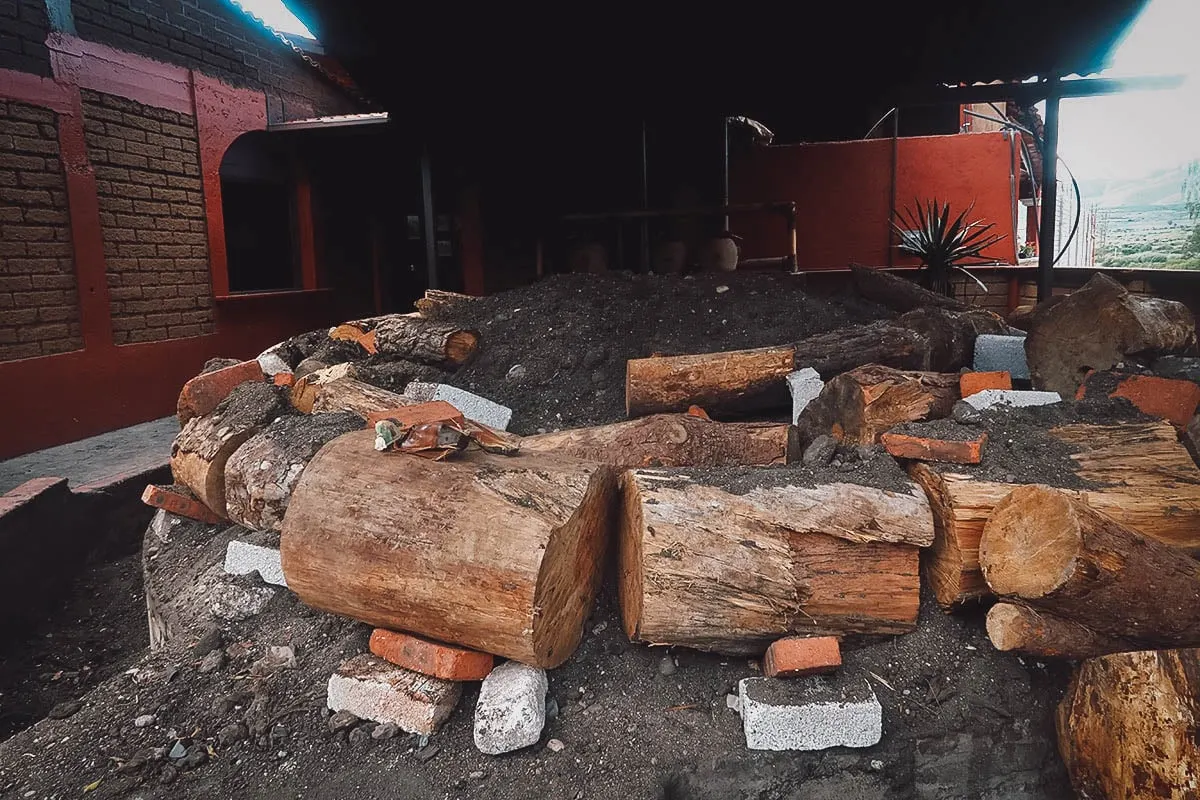
After roasting, the agave plant hearts are then crushed and mashed using a heavy stone wheel pulled by a horse. I forgot to ask our tour guide if more modern methods are used these days but according to him, many horses are used in rotation to keep them from being overworked.
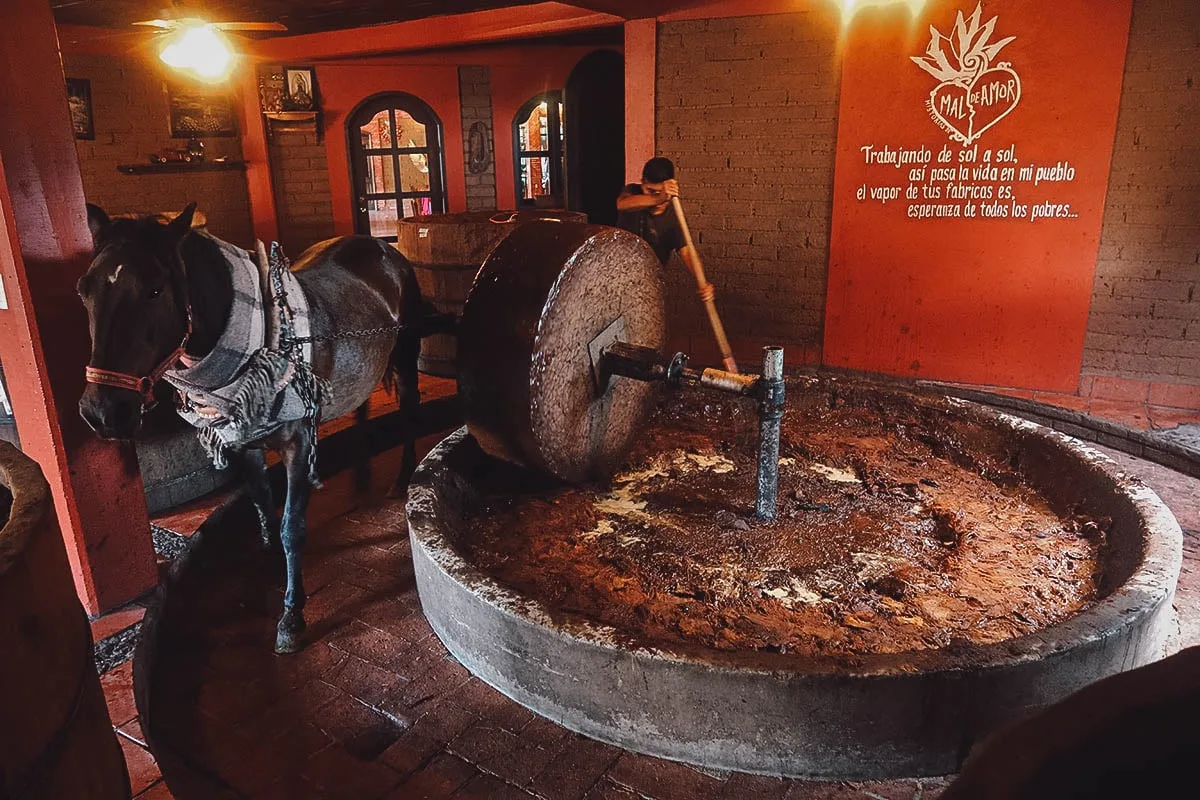
The mashed agave is then mixed with water and left to ferment in large vats or barrels. I find the smell of fermenting agave mash to be quite wonderful – musky, sweet, even fruity.
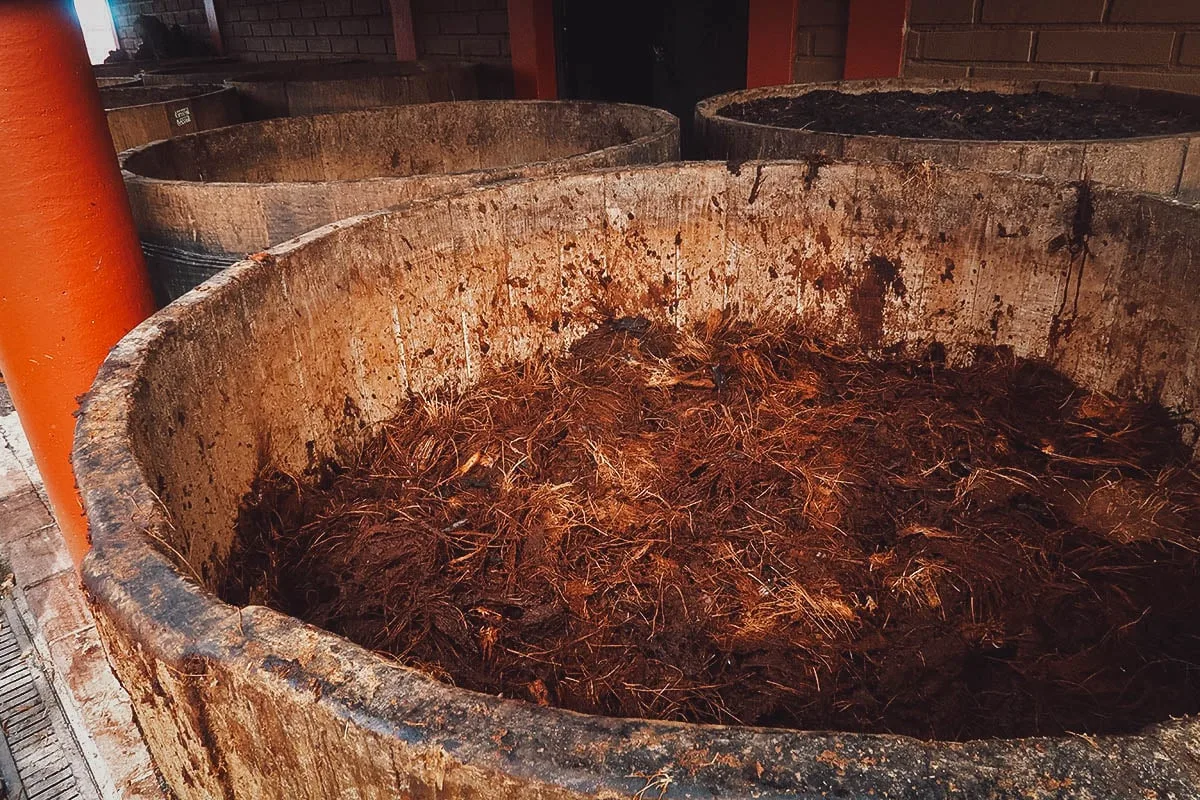
This was the best part of this Oaxaca mezcal tour. If the tour ended after a ride on this barrel truck, then I still would have been a happy man.
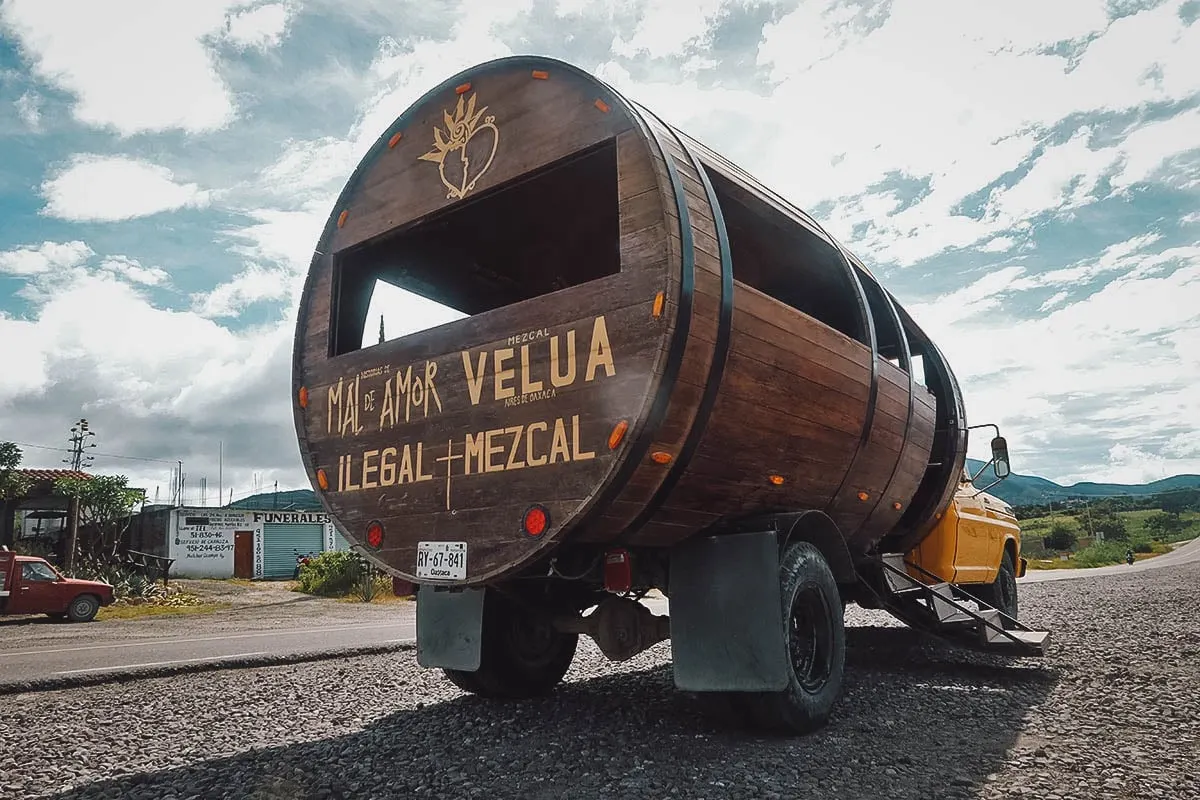
Joining us on the mezcal barrel ride were two of Palenque’s Mal de Amor tour guides.
We were lucky to be the only two people on today’s tour but you can tell that the tour guies are used to entertaining buses full of tourists. Party music was blaring as they tried to get the energy up.
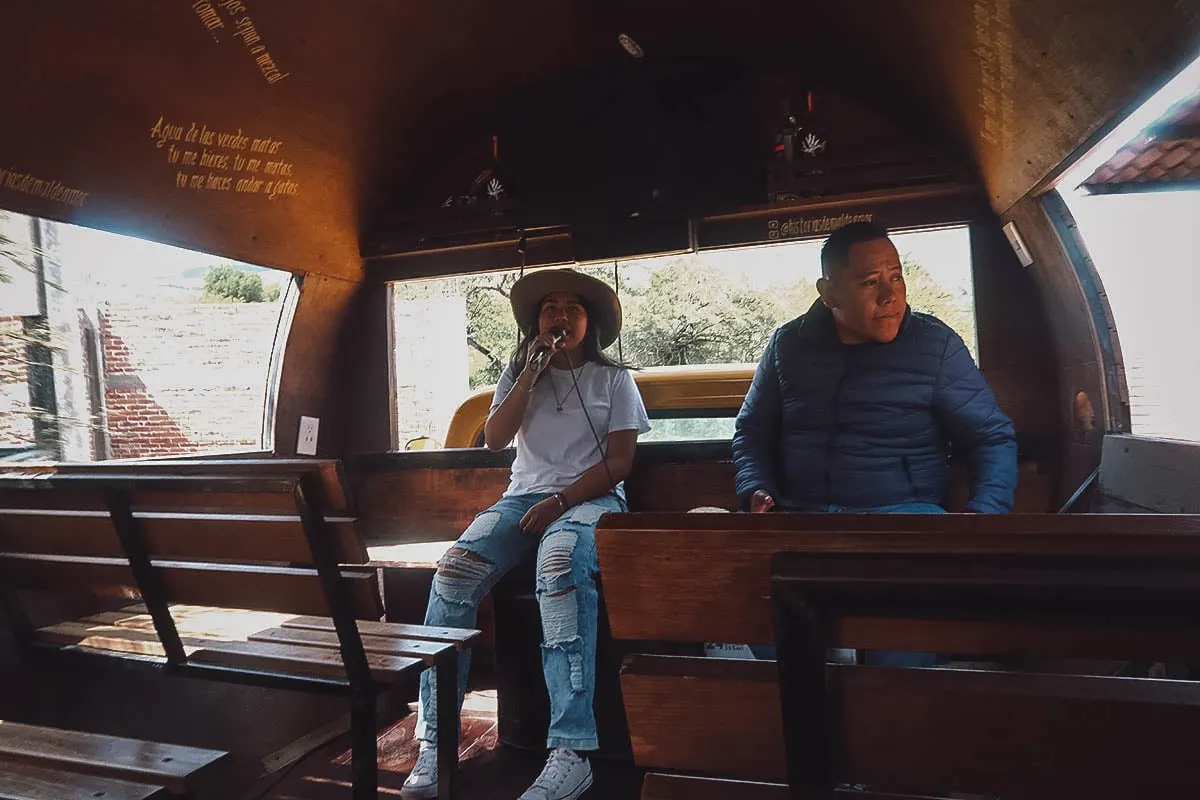
On this ride, you’ll realize just how big of an operation Palenque Mal De Amor really is. You’ll ride through agave fields with row after row of maguey espadín plants.
Word of caution, it’s an extremely bumpy ride so keep that in mind if you’re prone to motion sickness.
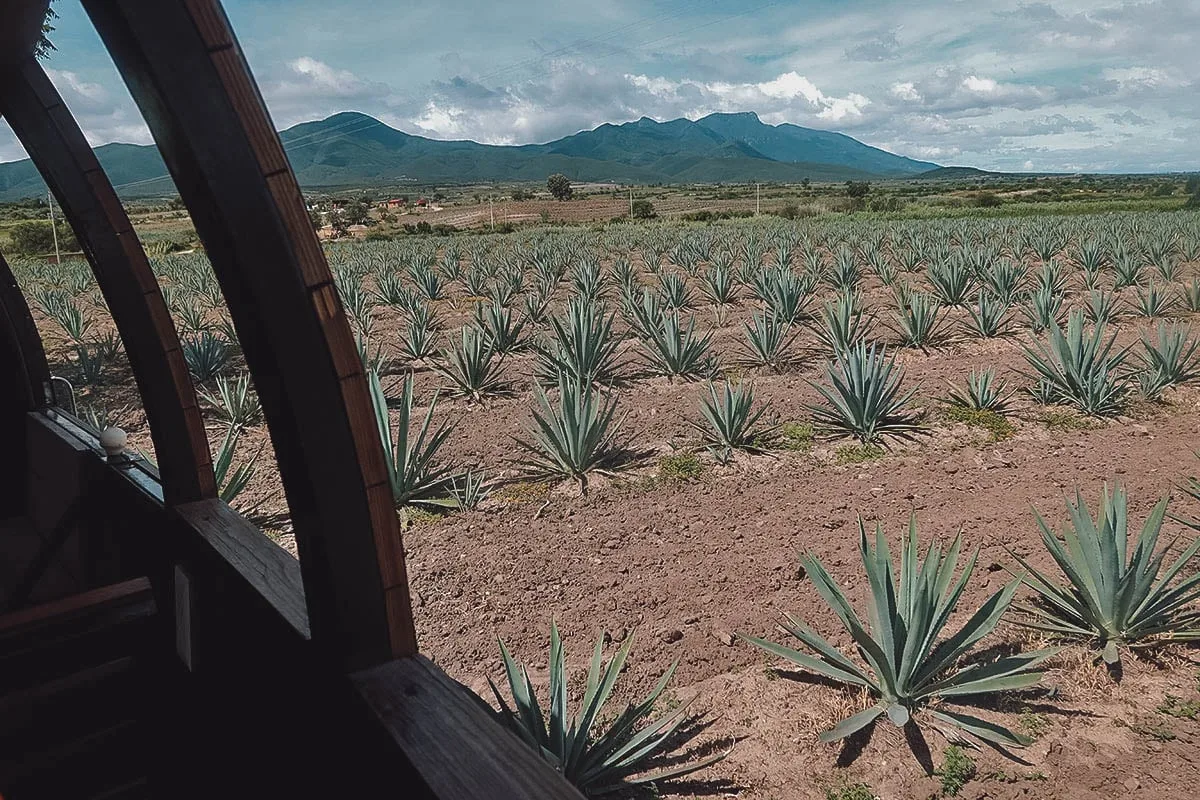
As described, maguey espadín plants account for over 90% of the total mezcal production in Mexico. This is because of their high sugar concentration which can yield larger volumes of agave spirit.
It takes about 9 kg (20 lbs) of espadín to make a liter of mezcal, unlike some wild agaves that need more than triple that amount.
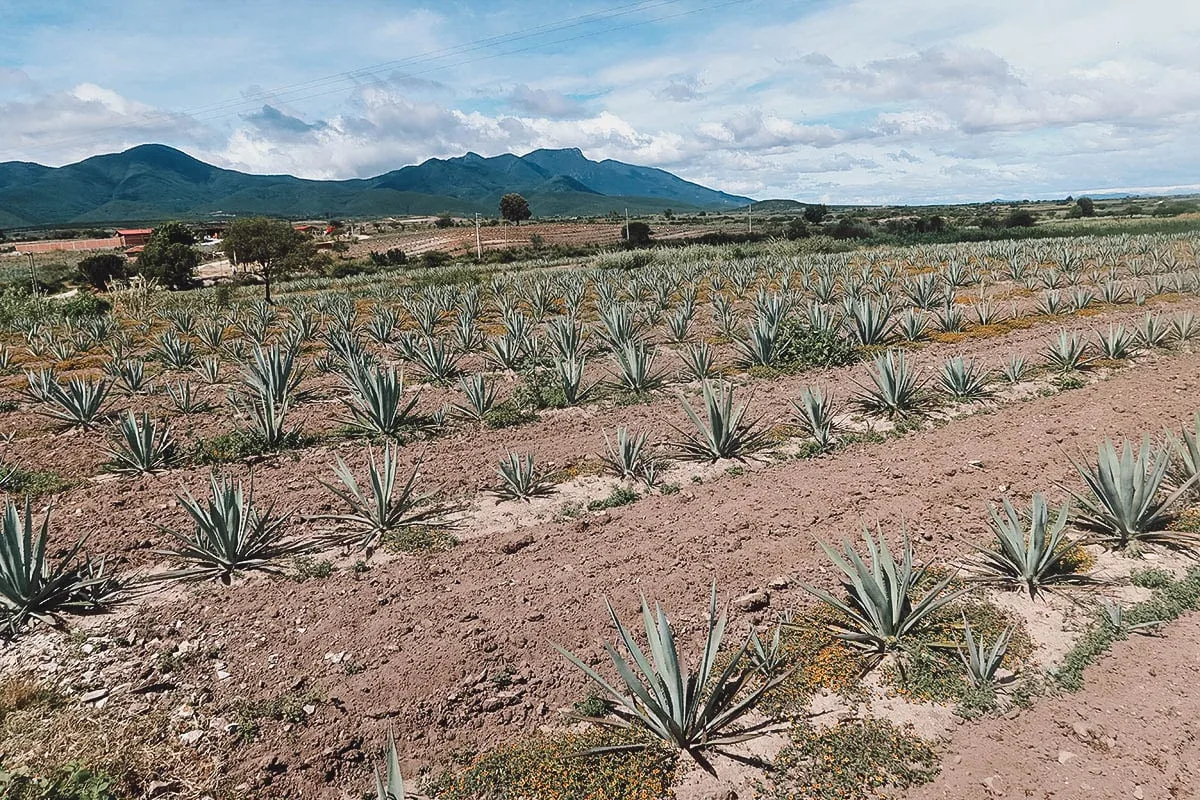
If you’re wondering what the main difference is between mezcal and tequila, then the answer is in the species of agave plant used. Tequila is always made from blue agave while mezcal can be made from any type of agave plant.
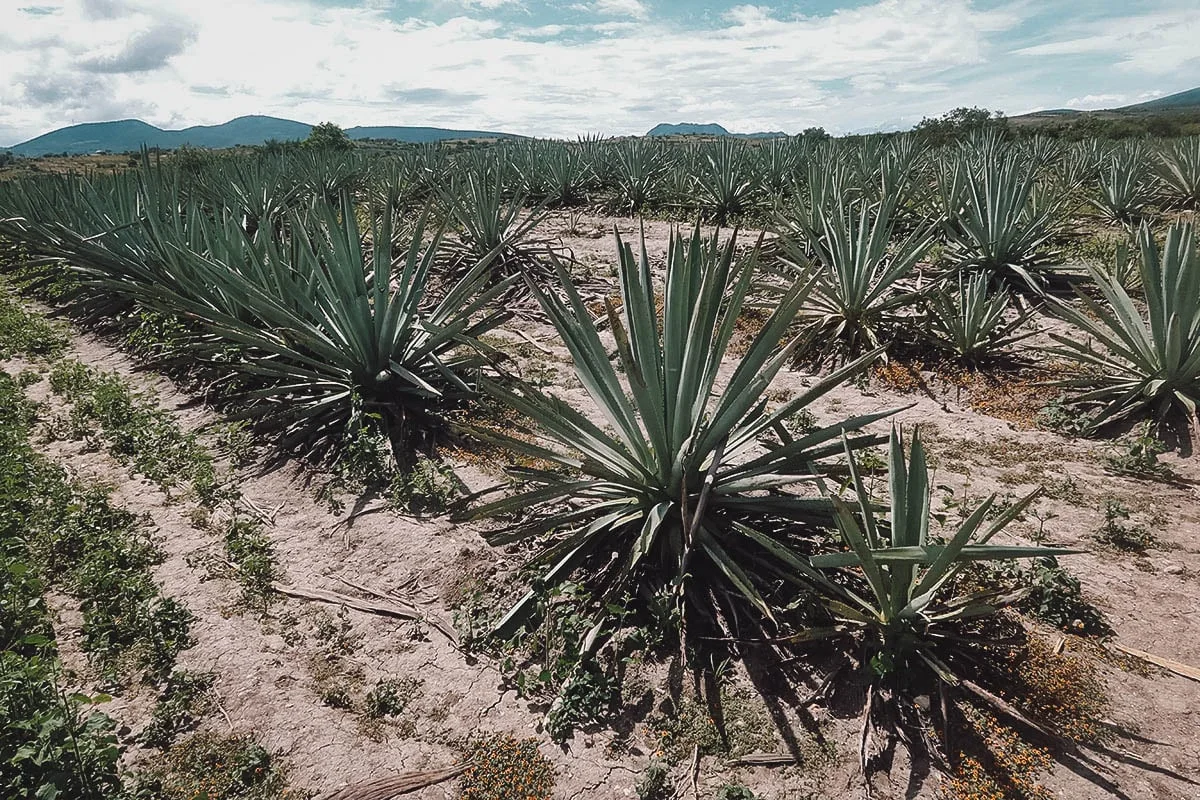
After driving into the heart of the agave fields, we got off the bus to do two things.
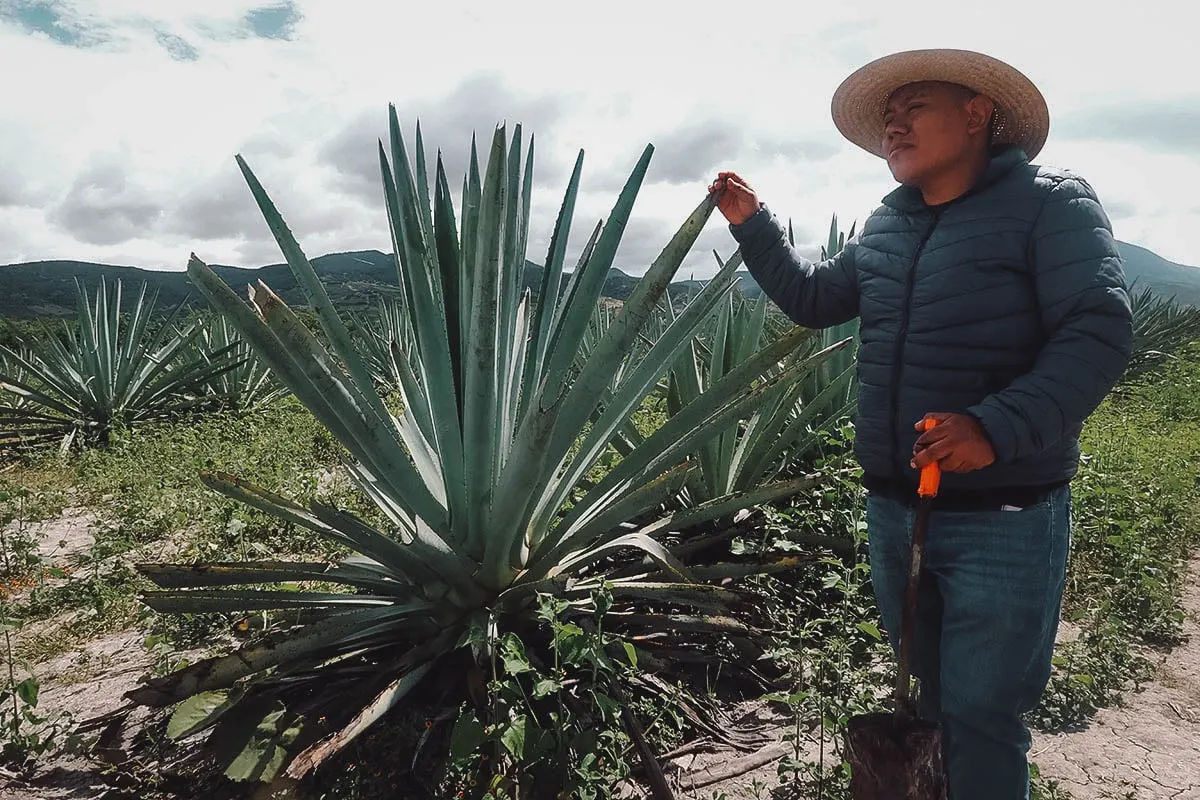
The first was to carve our names into the agave leaves using a spine from the plant. Those things are super sharp!
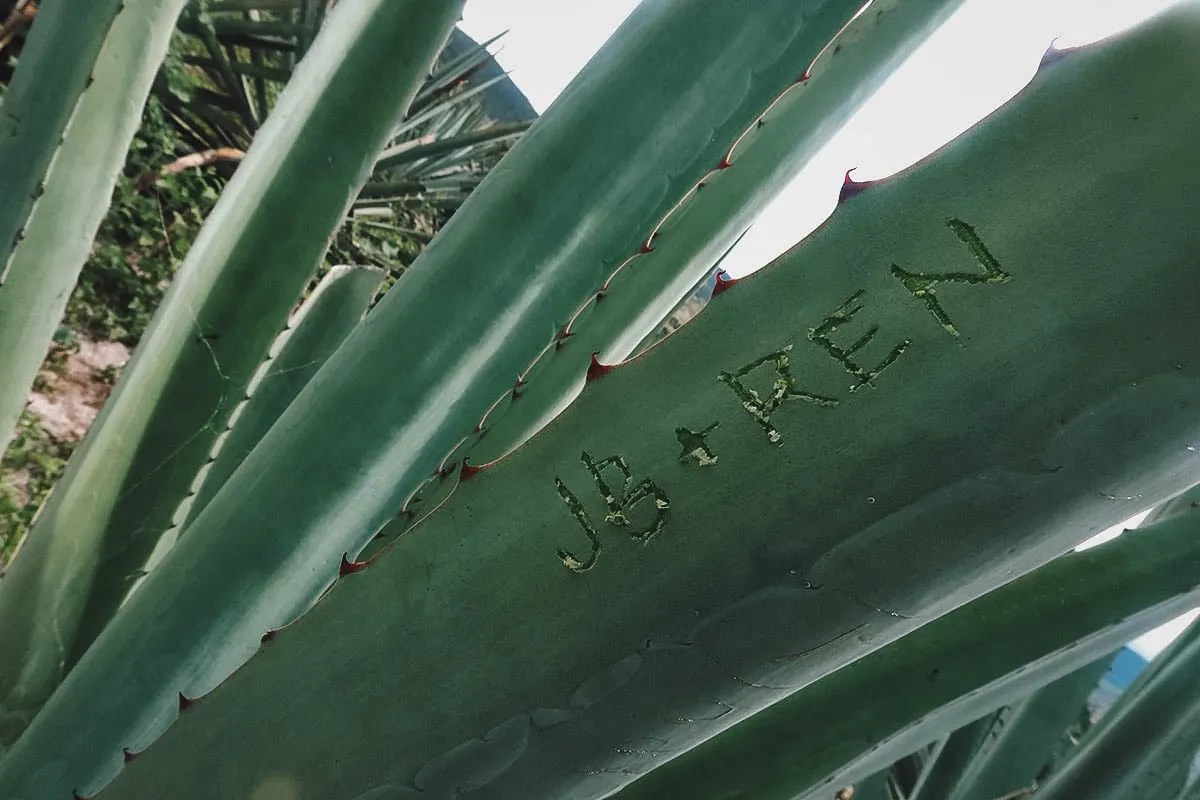
The second was to get a taste of mezcal like we had never experienced before.
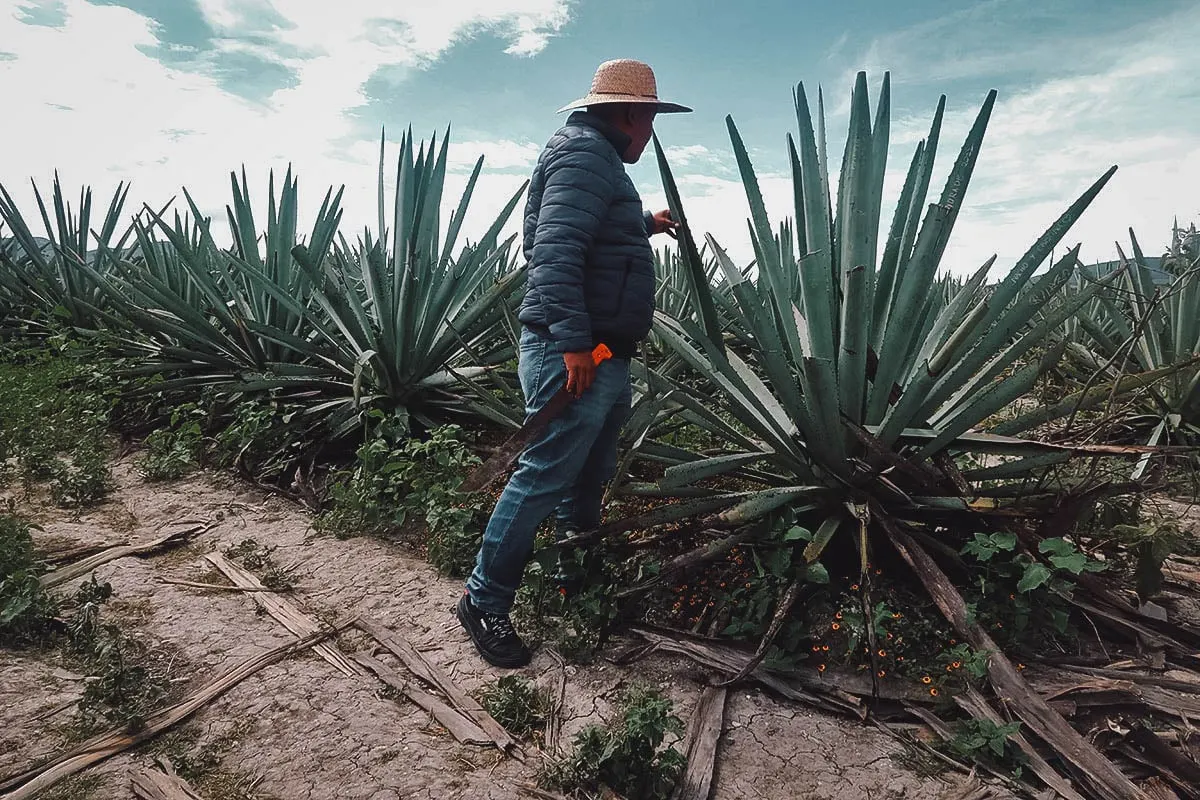
Our tour guide cut an agave leaf off with his machete (which I got to try myself as well) and used it as a vessel for us to drink mezcal. He’d pour mezcal onto the leaf and into our gaping mouths.
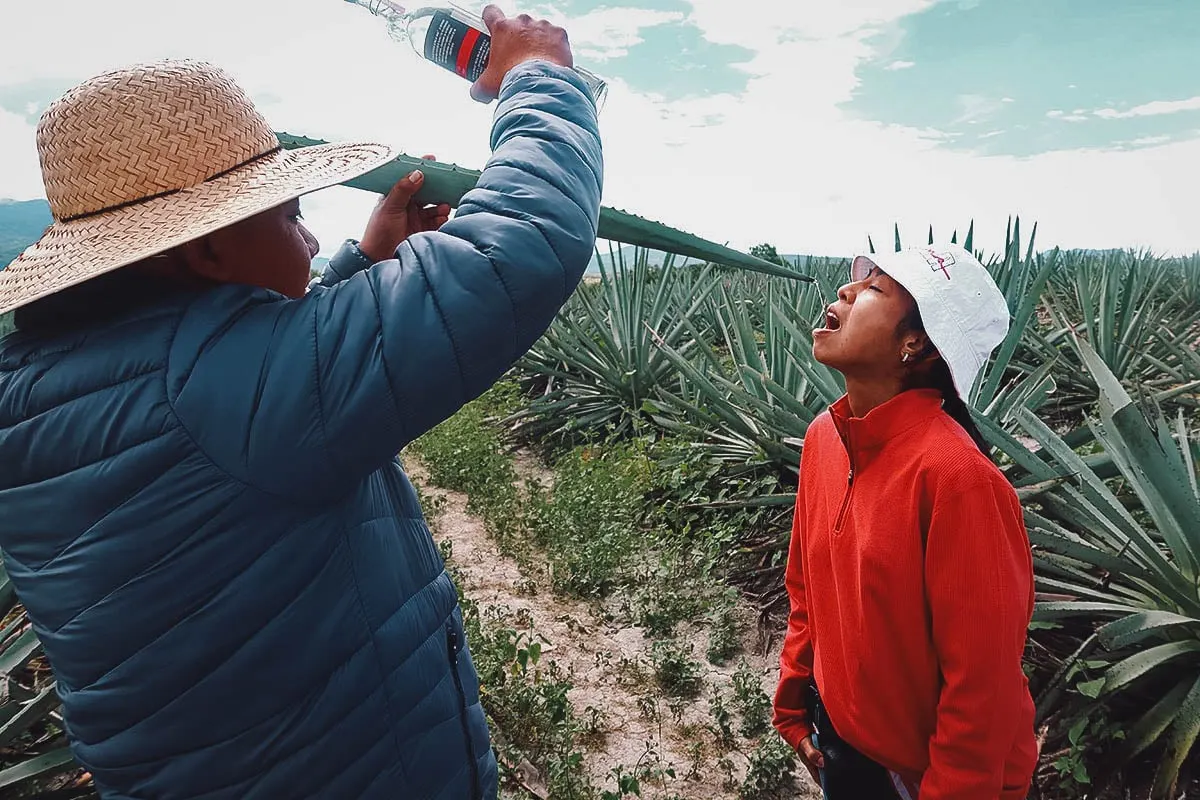
Mezcal is enjoyable enough on its own but drinking it in this fashion was an entirely new and unexpected experience. The mezcal tasted colder and fresher, like we were drinking it straight from the heart of the agave.
Our tour guide didn’t pour us just enough for a little sip either. He gave us as many mouthfuls as we could take. It was awesome.
Drinking mezcal from an agave leaf in the middle of a maguey plantation in Oaxaca isn’t an experience we’ll be forgetting anytime soon.
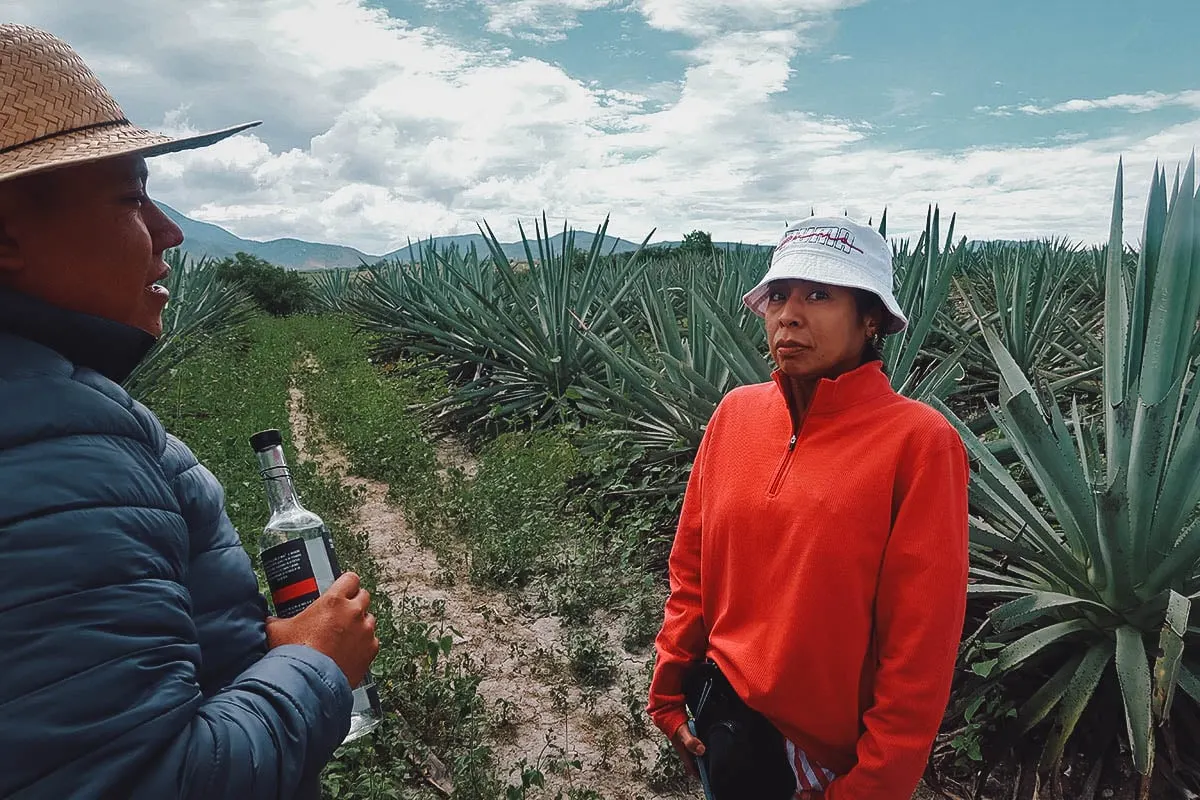
The barrel ride would continue with our tour guides offering a toast while we downed shot glass after shot glass of mezcal. Can you imagine how much fun this mezcal tour would be with a bus full of friends?
In Oaxacan mezcal culture, there’s a saying that goes: “Para todo mal, mezcal, y para todo bien, también; y si no hay remedio litro y medio”.
That translates to something like “For all bad, mezcal, and for all good, [mezcal] as well; and if there is no remedy, [then take a] liter and a half.”
¡Salud!
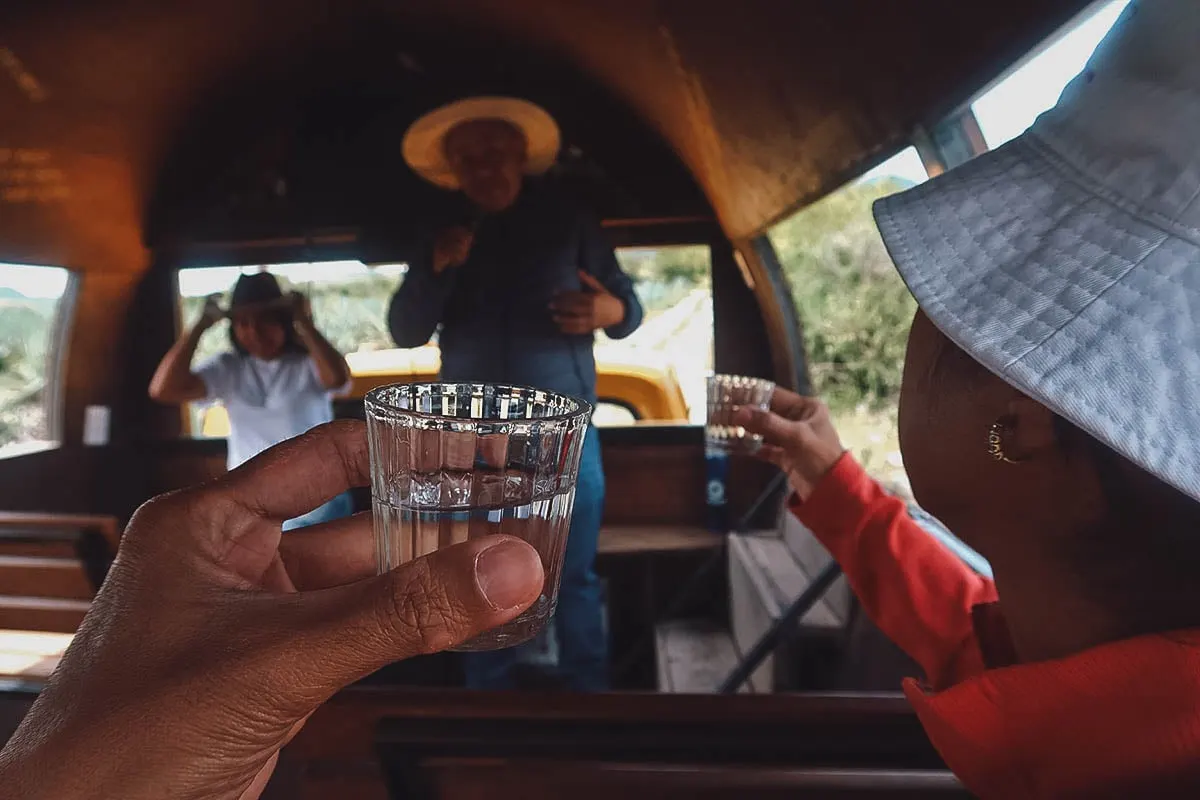
We thought the barrel ride would end there but no, we would later be taken to a small pulqueria within the plantation’s grounds to try other agave derivatives. In the clay pots below are tepache, pulque, and aguamiel.
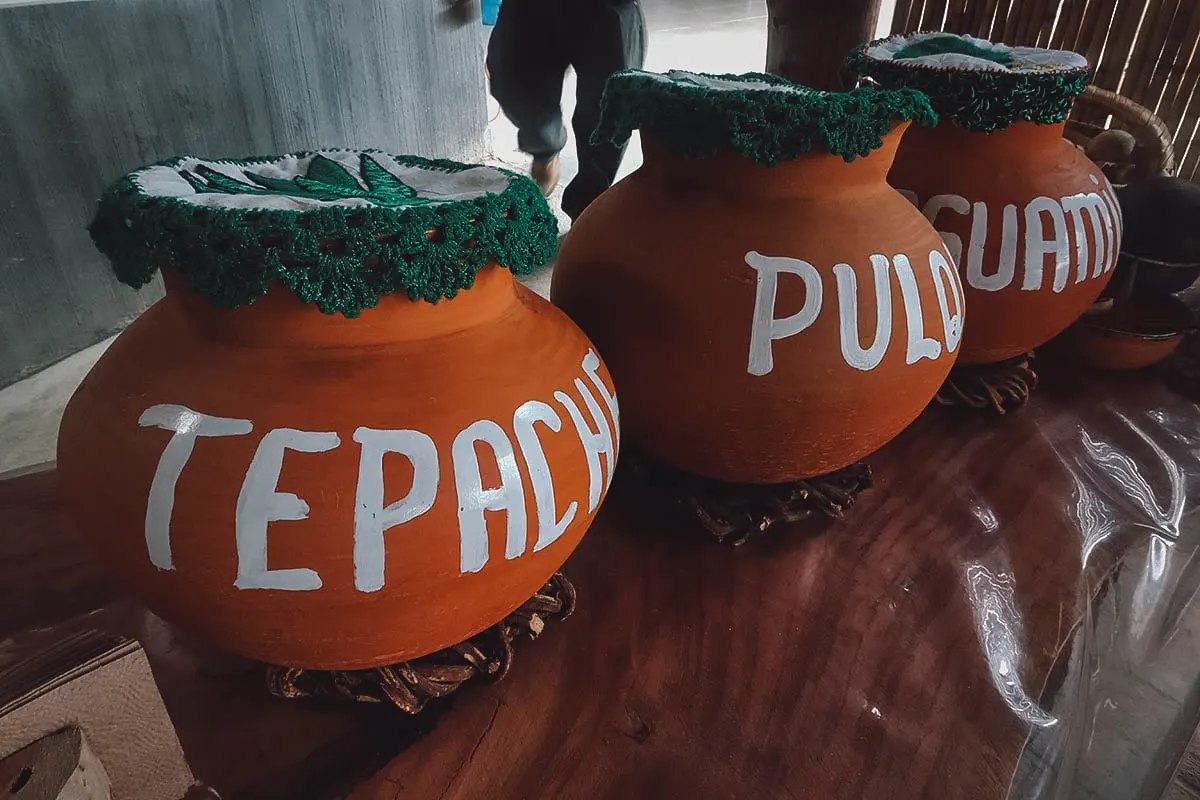
Here’s the pulquero pouring us cups of fresh pulque. Like mezcal, pulque is a drink you’ll probably enjoy often in Mexico. Thick and viscous, it refers to an alcoholic beverage produced from the fermented sap of the maguey plant.
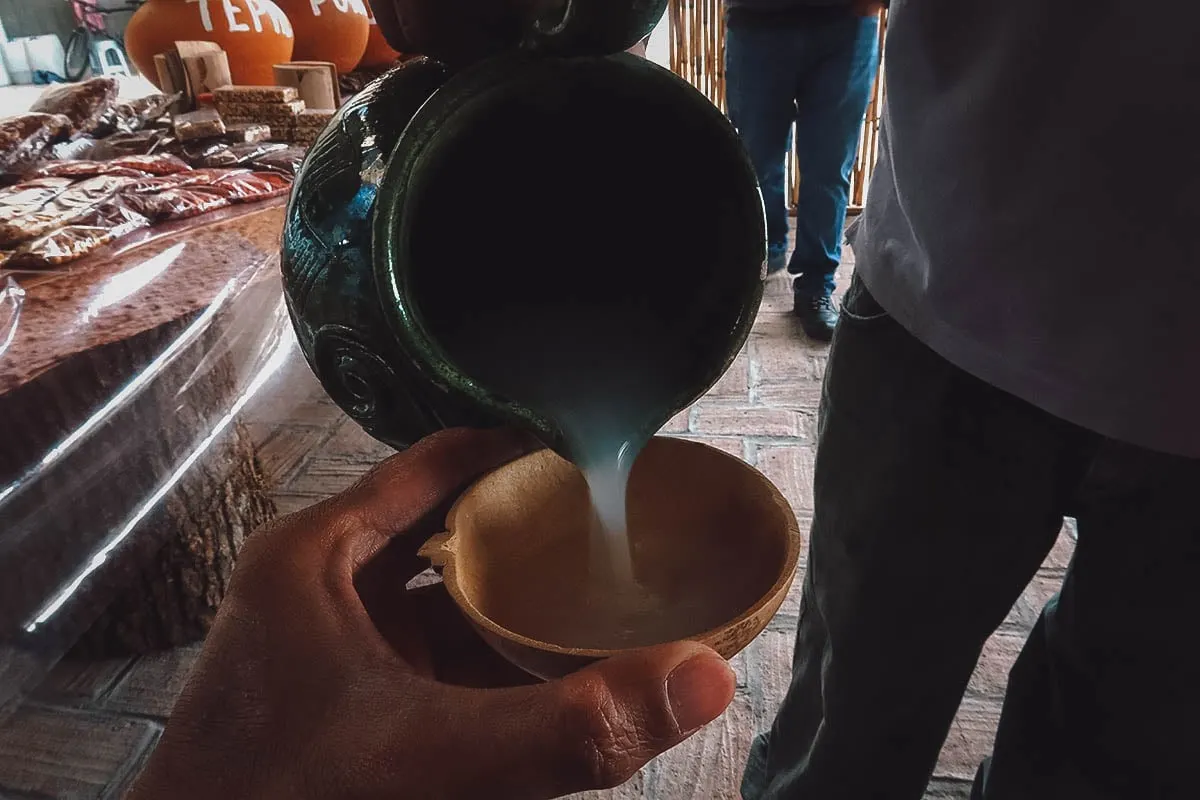
Pictured below is a cup of tepache, a fermented beverage made from pineapple rinds. Tepache is traditionally made from corn though contemporary recipes are more commonly made with pineapples.
Unlike mezcal and pulque, tepache contains very little alcohol. It’s sweetened with piloncillo (unrefined whole cane sugar) and typically served cold.
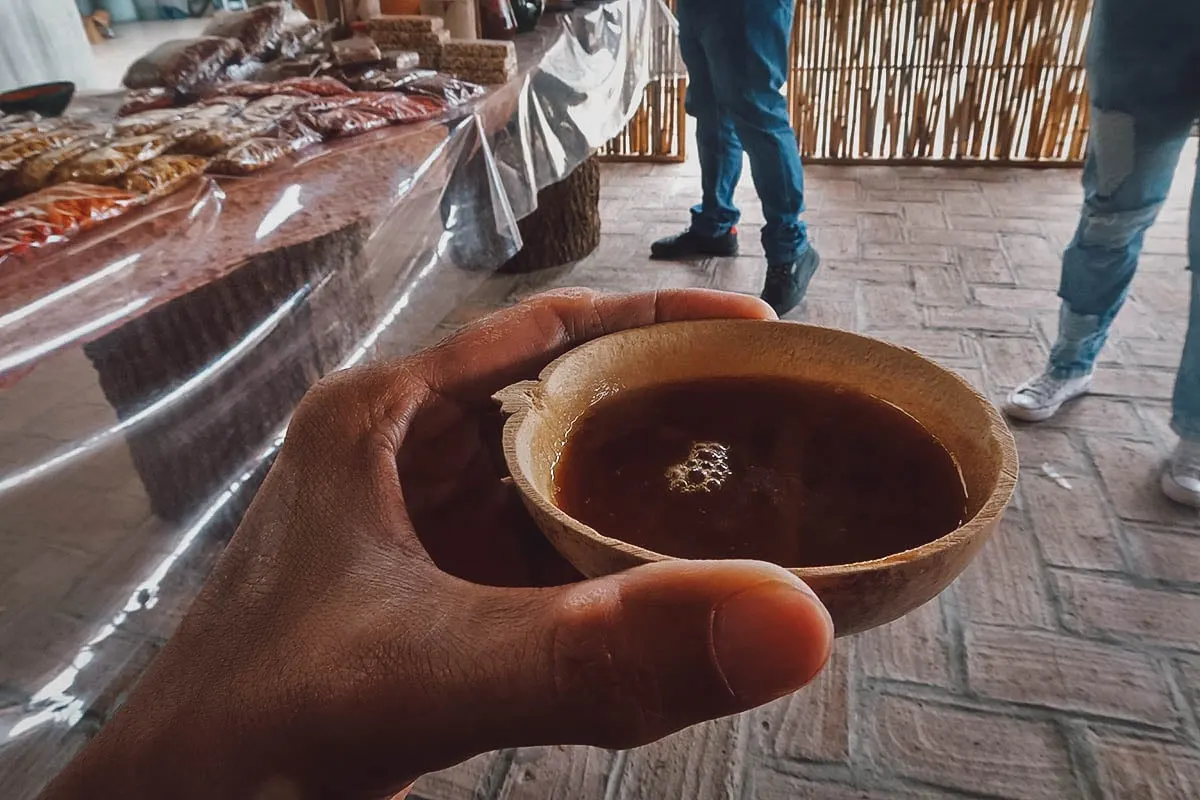
The last tasting on this Mal de Amor mezcal distillery tour was this cup of aguamiel. Also known as honeywater, aguamiel refers to the unfermented sap of the maguey plant.
We enjoyed mezcal and pulque many times in Mexico but this was the one and only time we got to try aguamiel. It’s delicious and refreshing and helps you understand how the high concentration of sugars in agave plants makes it suitable for making spirits like mezcal.
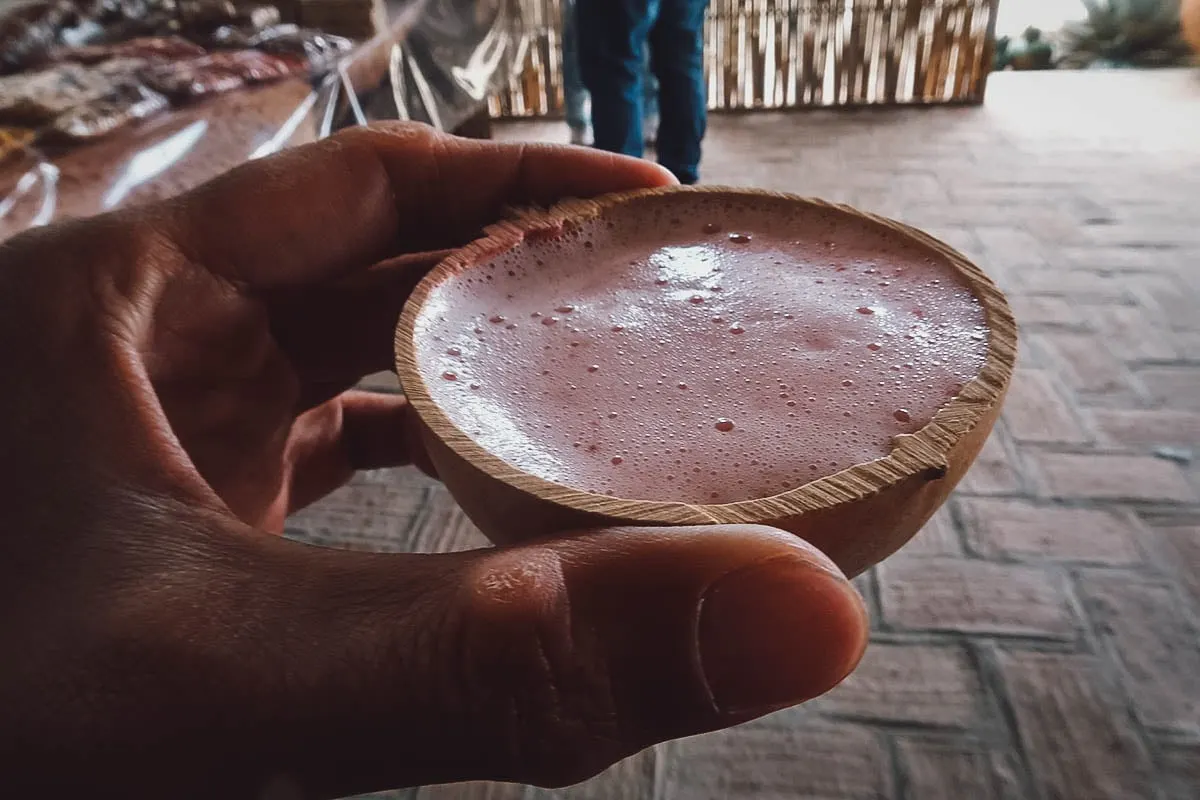
SECOND STOP: Mezcal Don Agave
The next stop on our Oaxaca mezcal tour was this medium-sized distillery called Mezcal Don Agave. If I remember our guide correctly, he said that this mezcal distillery is equally famous for its restaurant so this was where we stopped to have lunch.
Pictured below is a delicious platter of enmoladas with tasajo (dried beef).
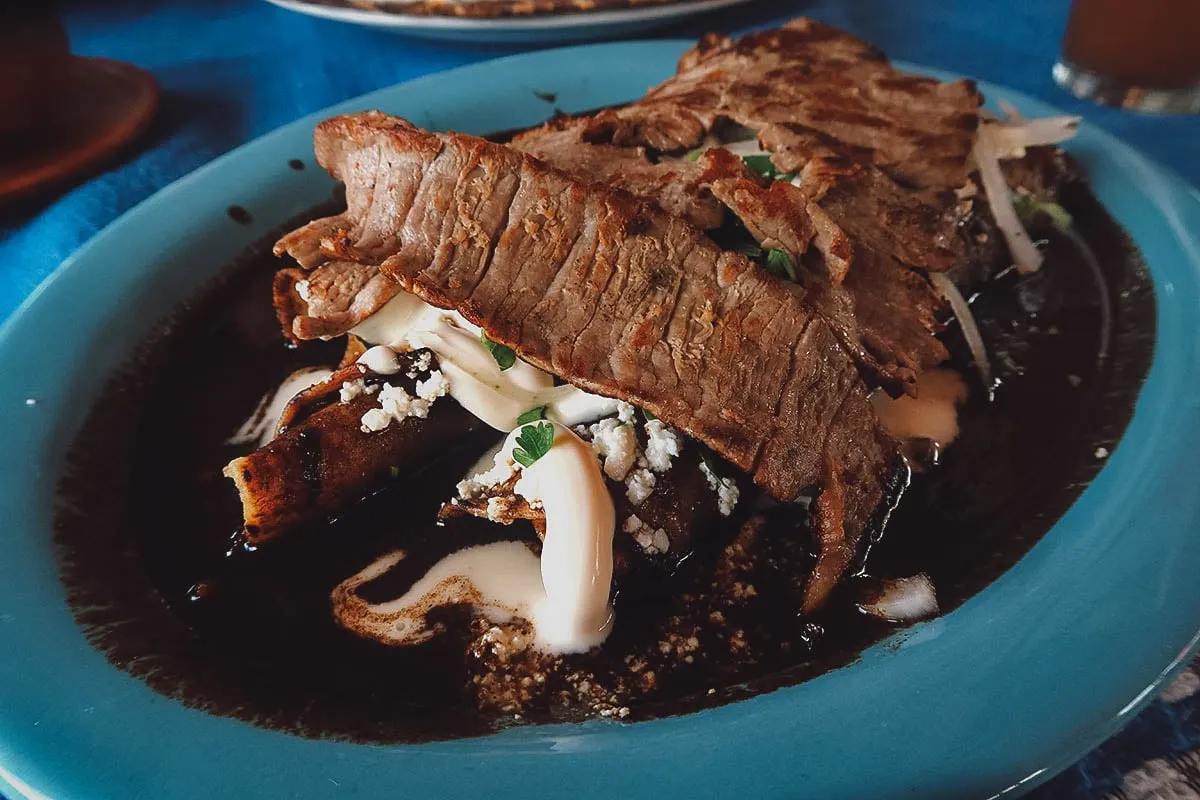
You can’t visit Oaxaca without trying tlayuda. Resembling a pizza, it’s a Oaxacan dish made with a large toasted tortilla topped with refried beans, unrefined pork lard, Oaxaca cheese, and other ingredients. ¡Que rico!
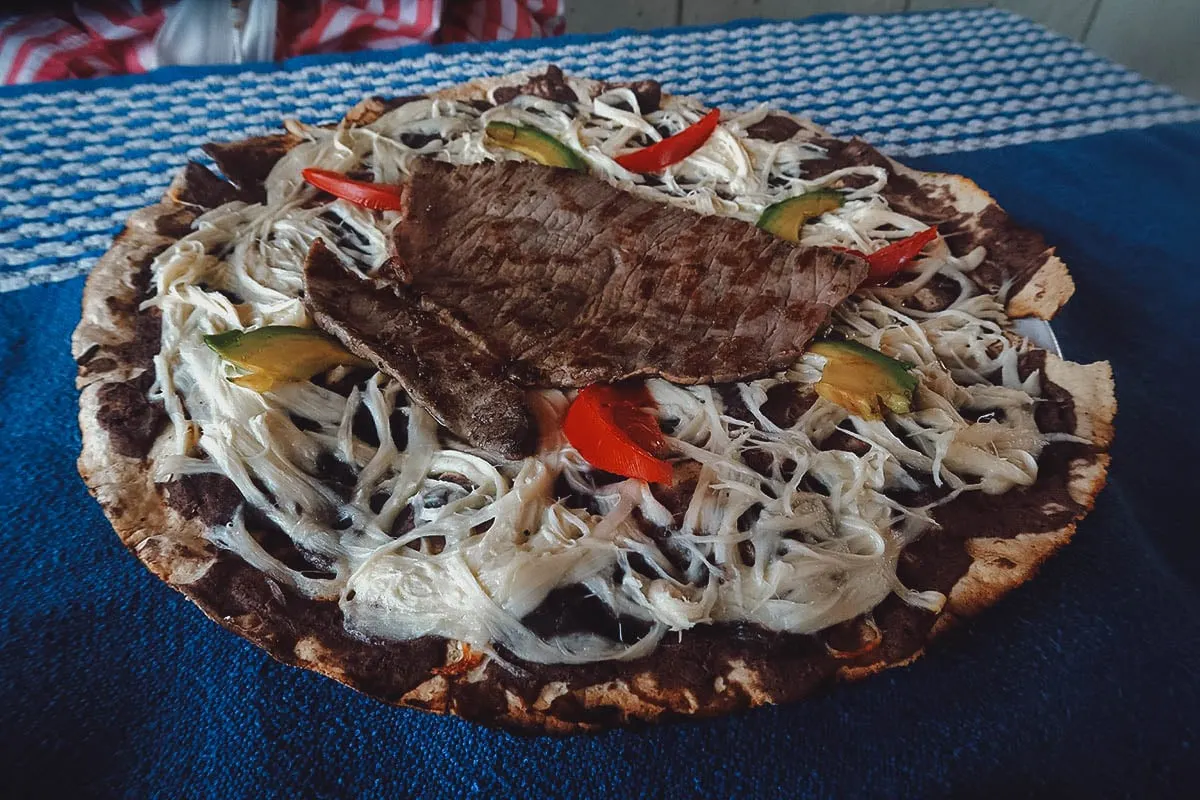
After lunch, our tour guide took us to the distillery’s agave farm to look at wild agaves. If you compare these to the espadín plants from Palenque Mal de Amor, you’ll notice how different they look.
There are around 270 recognized species of agave plants, of which around 30+ are used to make mezcal.
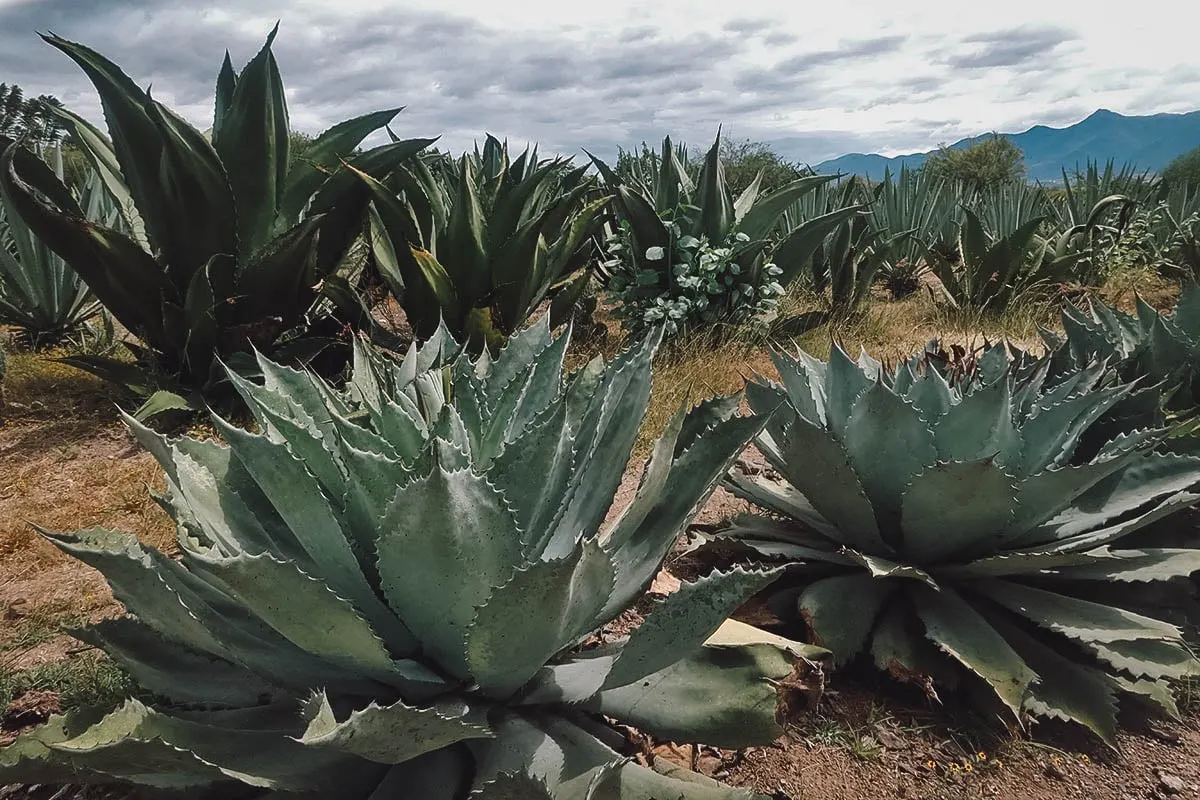
I don’t know what agave species this plant is but can you imagine how many you’d need to make a liter of mezcal? It’s no wonder espadín is so popular.
Because wild agave plants have a lower yield, mezcal made from these plants fetch a higher price.
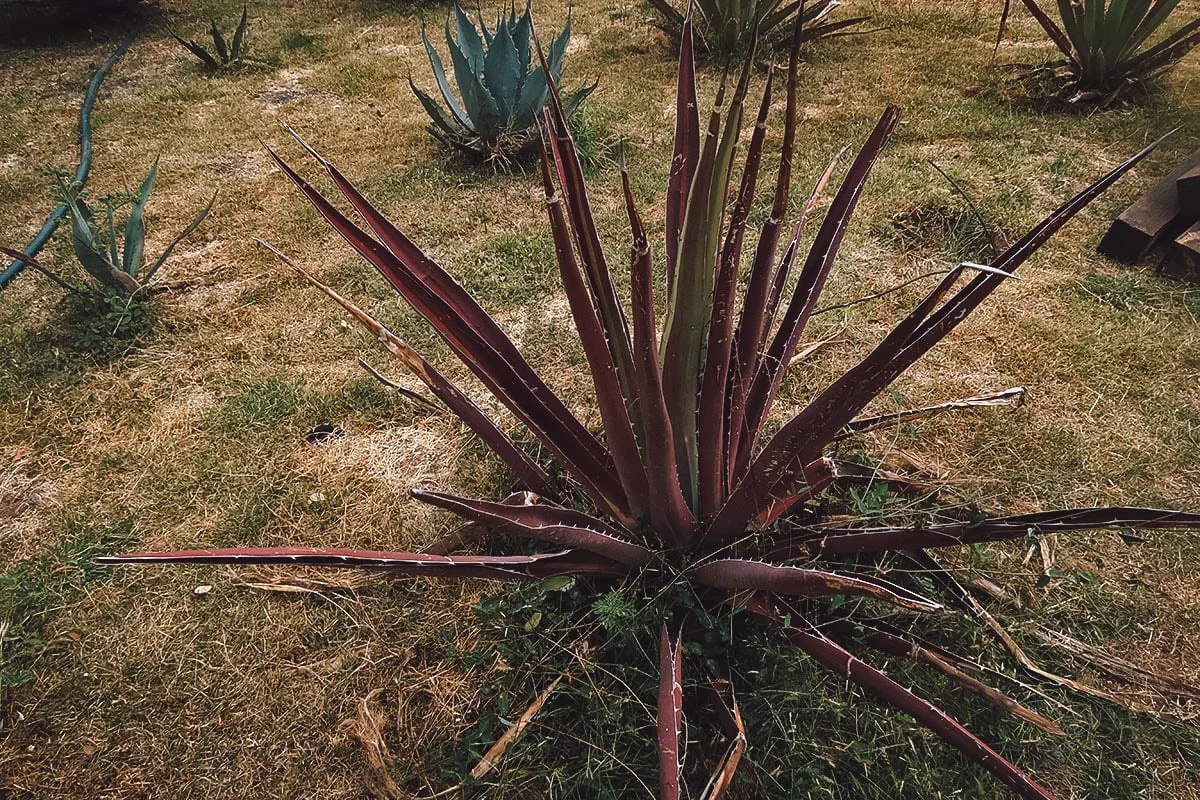
Here’s a picture of an open pit oven. These things are massive.
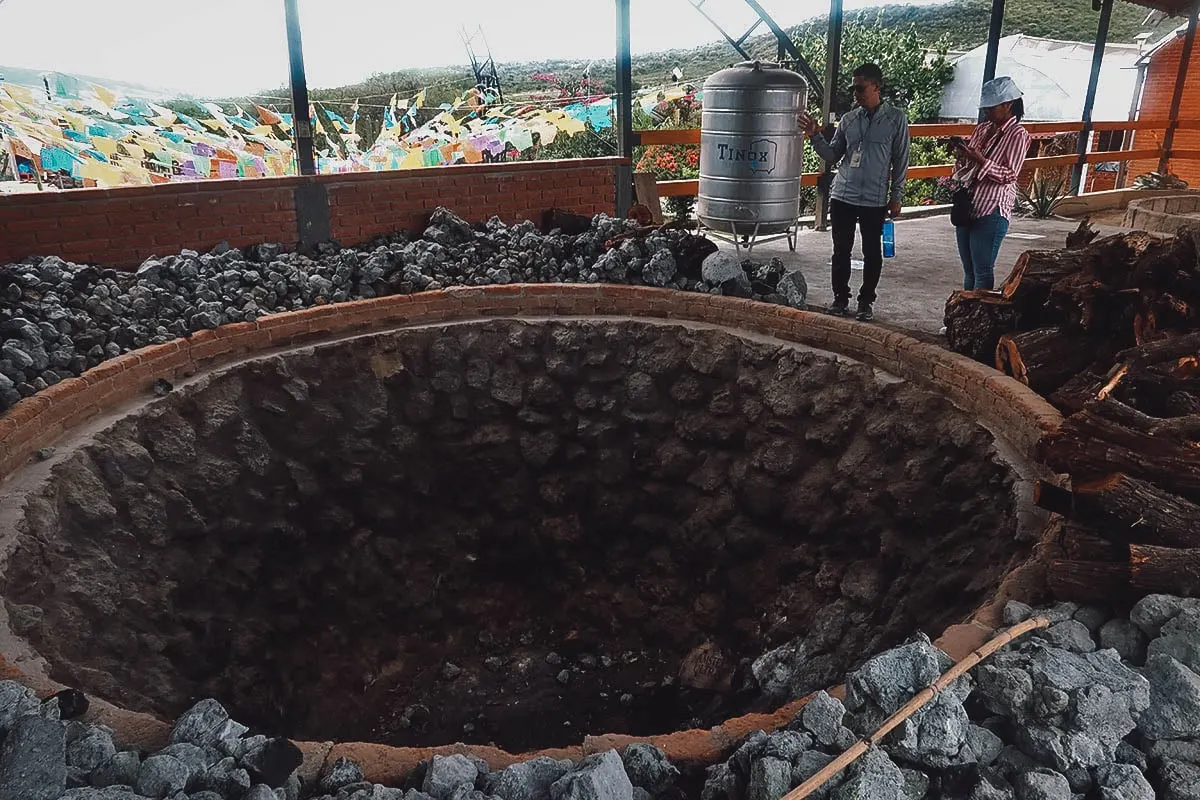
If I remember correctly, this is where the liquid from the fermented mash is distilled to modify its flavor before being bottled and sold.
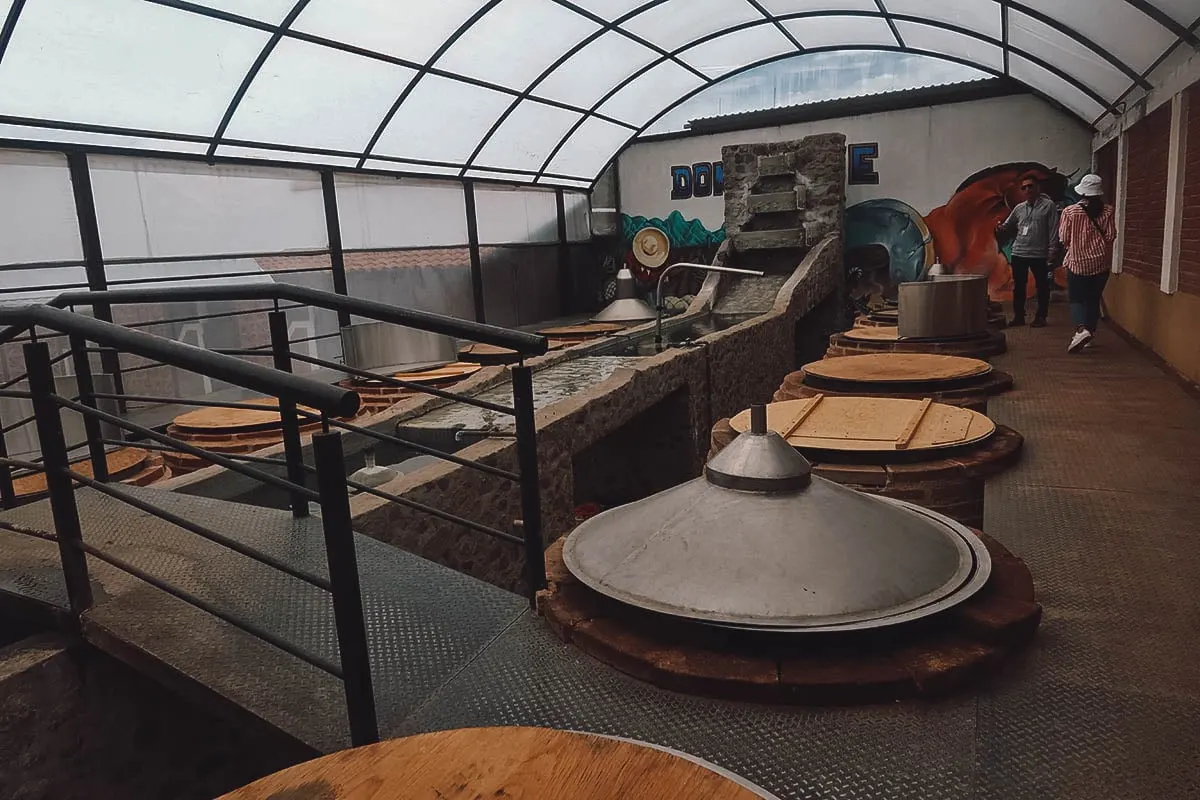
Every stop on this mezcal distillery tour is followed by mezcal tasting. I love it!
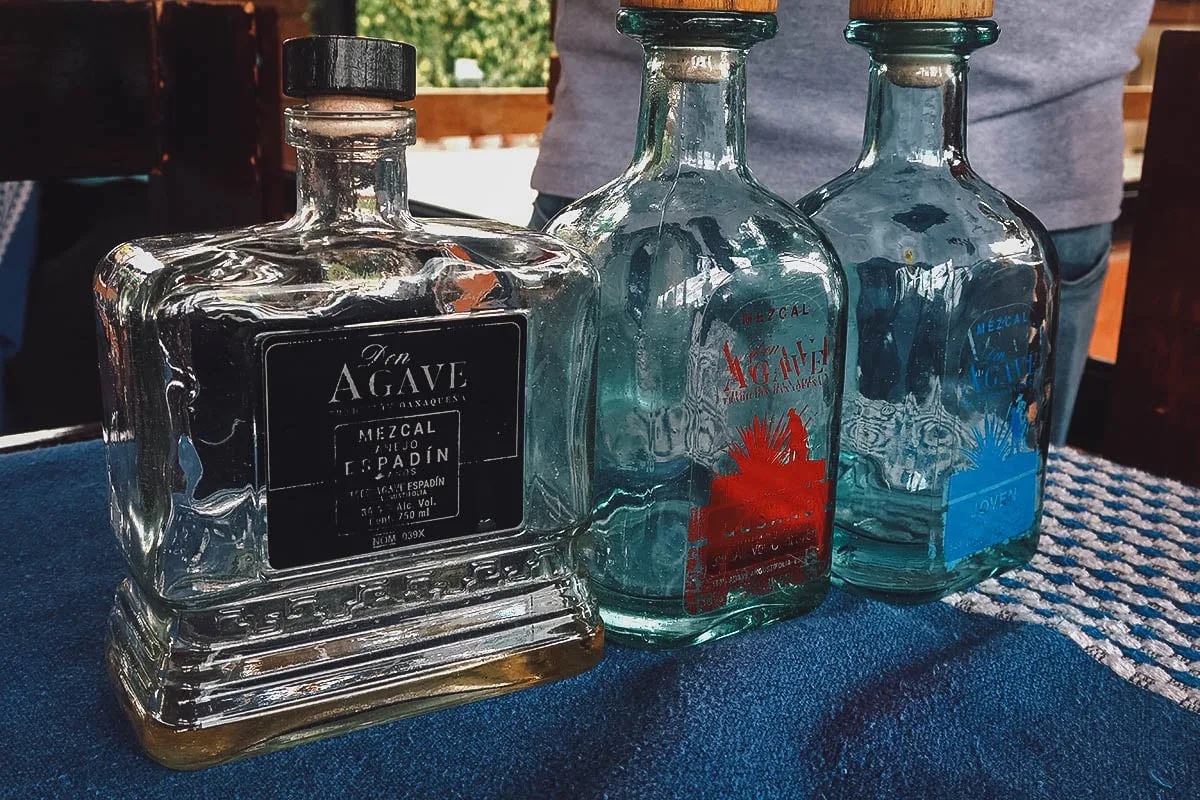
We got to sample three different types of mezcal, this time with wedges of lime.
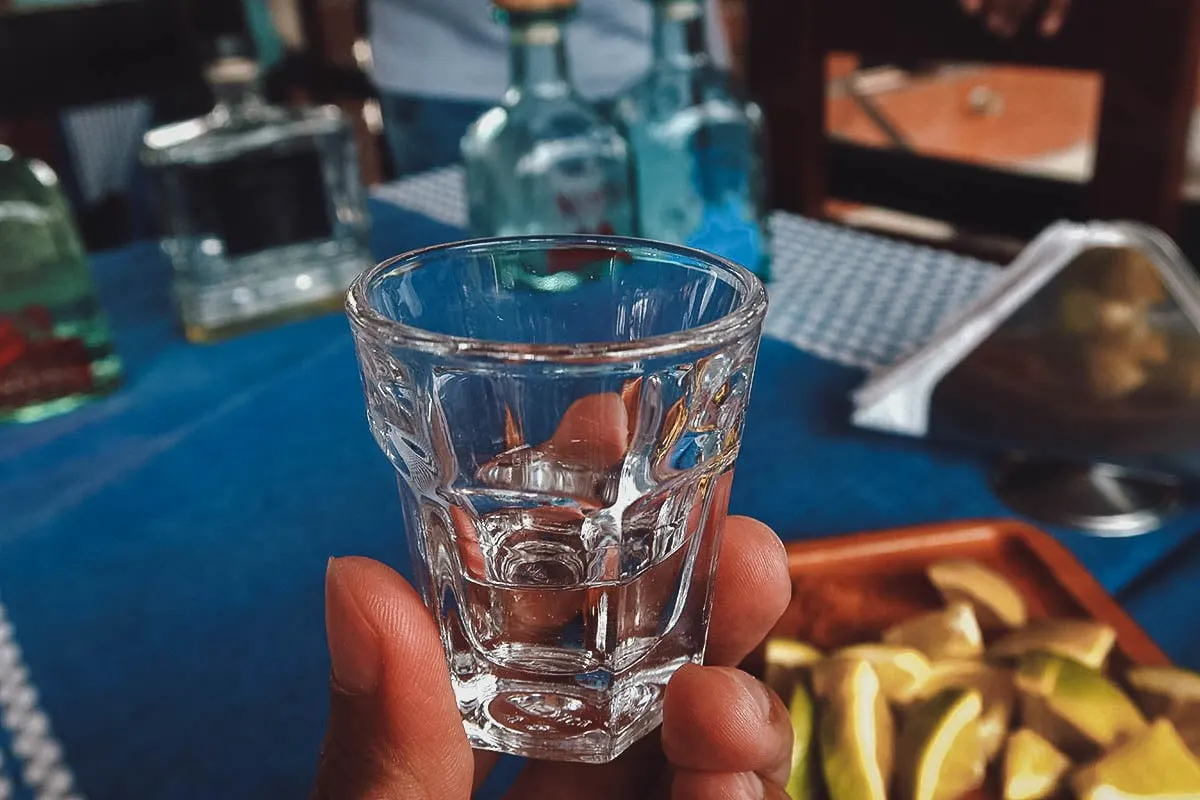
We didn’t get a taste but these beautifully designed bottles contained pricier artisanal mezcal made from different species of wild agave. If you’re looking to bring home a souvenir from this Oaxaca mezcal tour, then these bottles would make an eye-catching addition to your bar cabinet.
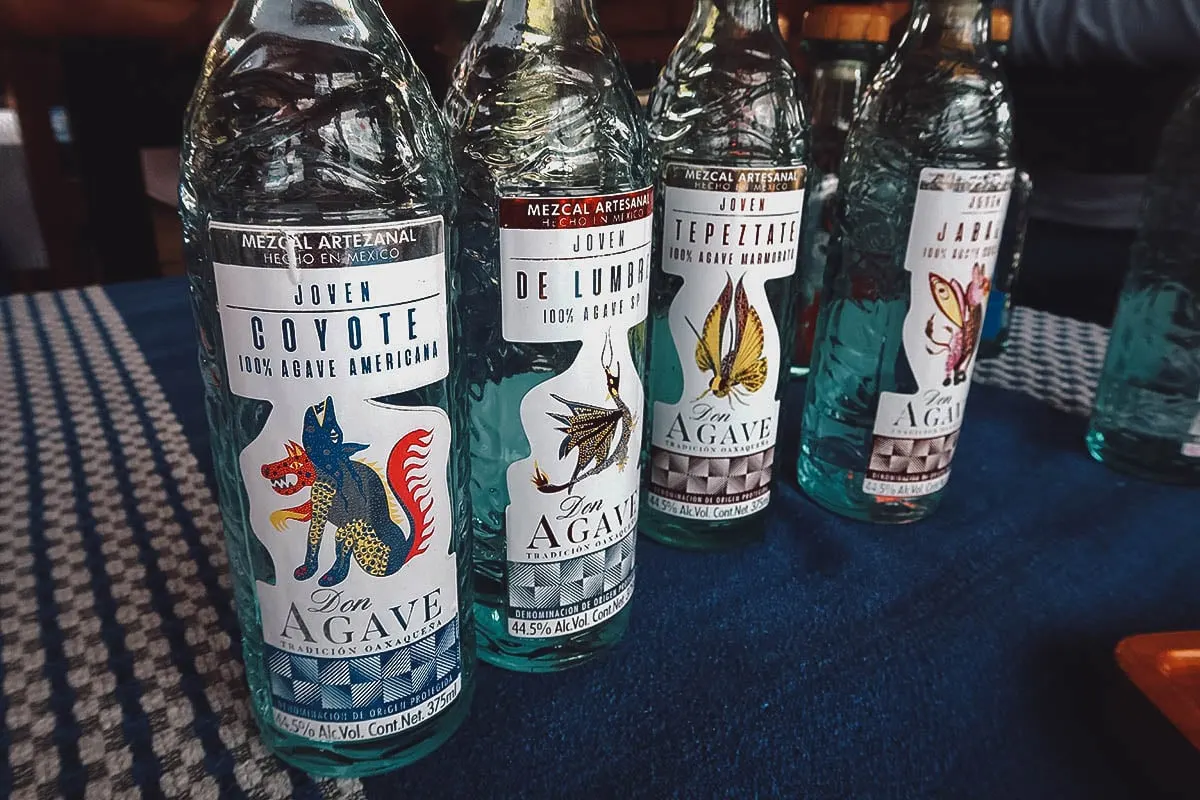
THIRD STOP: Mezcal Espina Dorada
The last Oaxaca mezcal distillery we visited on this tour was Mezcal Espina Dorada, one of the best family-owned distilleries in Oaxaca. They make mostly small-batch artisanal mezcal and do interesting things with the agave fibers so nothing goes to waste.
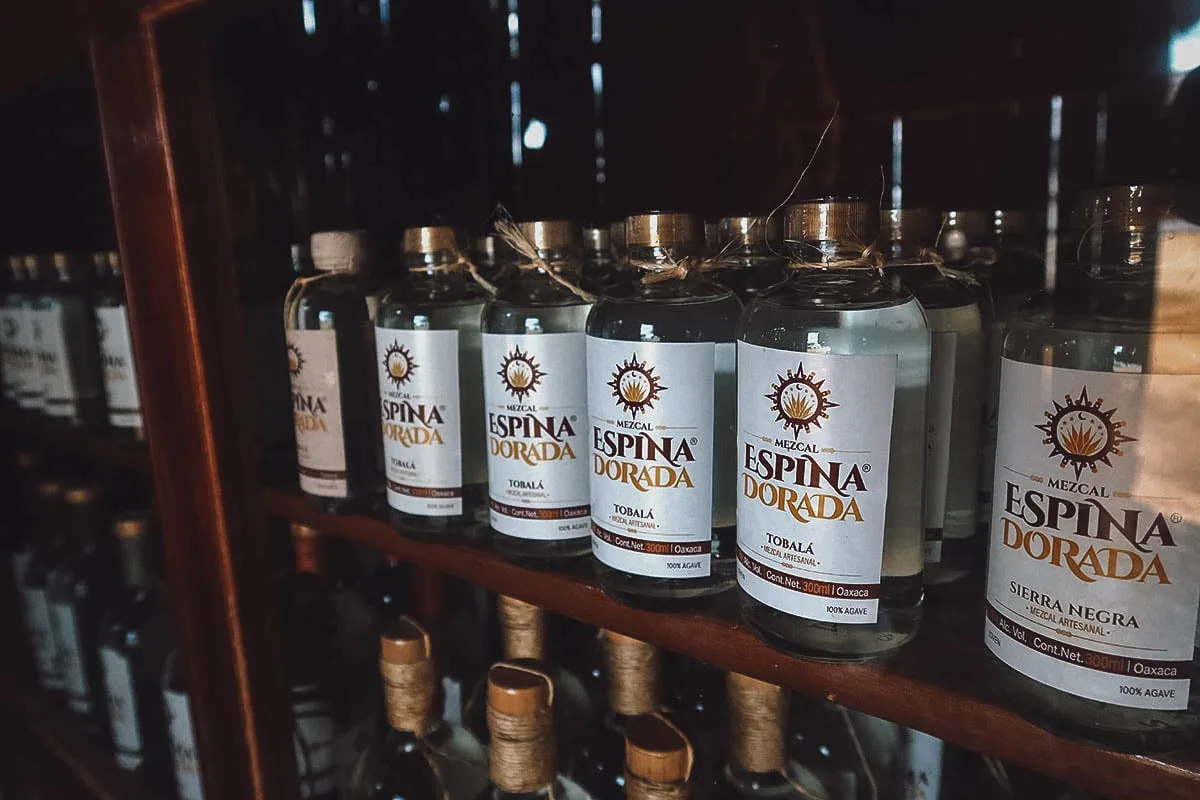
Mezcal Espina Dorada feels quite different from the larger commercial distilleries. It’s considerably smaller so it gives you a sense that more care is given to each batch of mezcal.
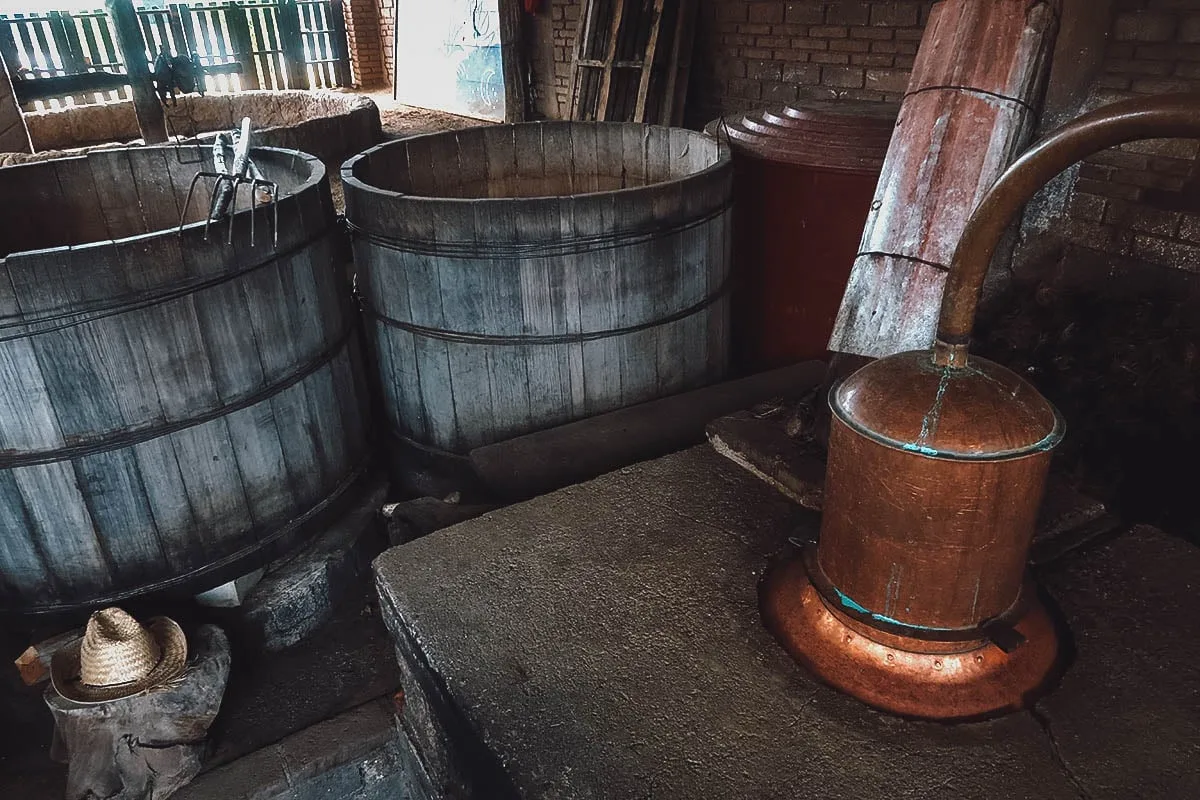
The distillery’s tour guide showed us around the palenque’s facilities and made special mention of the agave fibers used in the mezcal process.
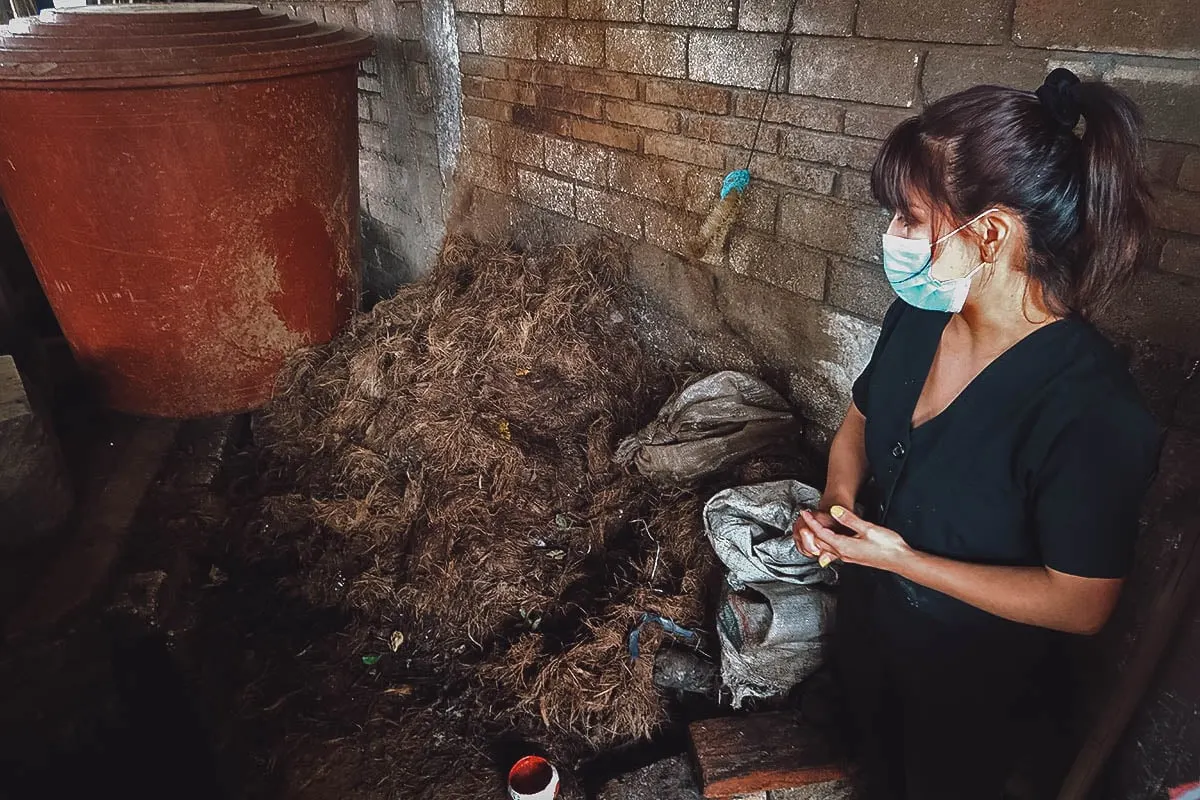
At Mezcal Espina Dorada, nothing goes to waste. Instead of being discarded, the agave fibers are dried and used to make other products like these planters. Awesome!
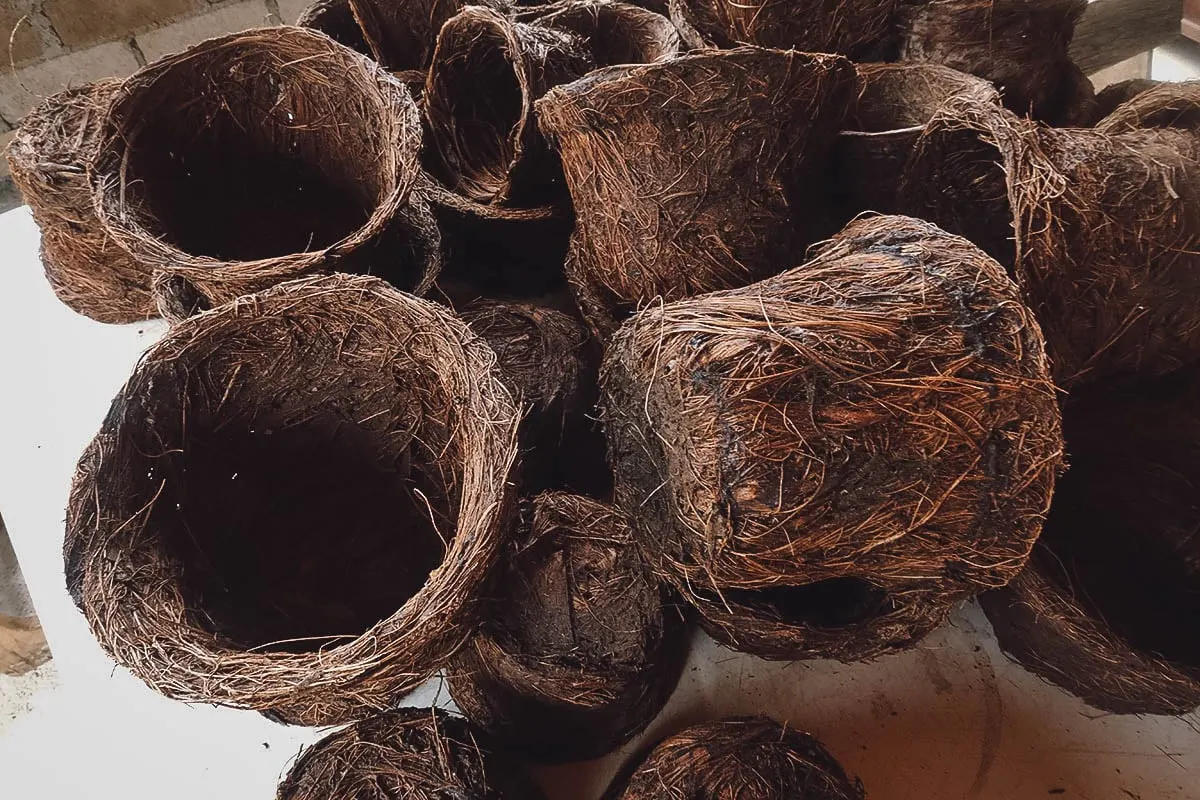
As expected, this mezcal distillery tour would end with mezcal tasting, starting with this bottle of espadín.
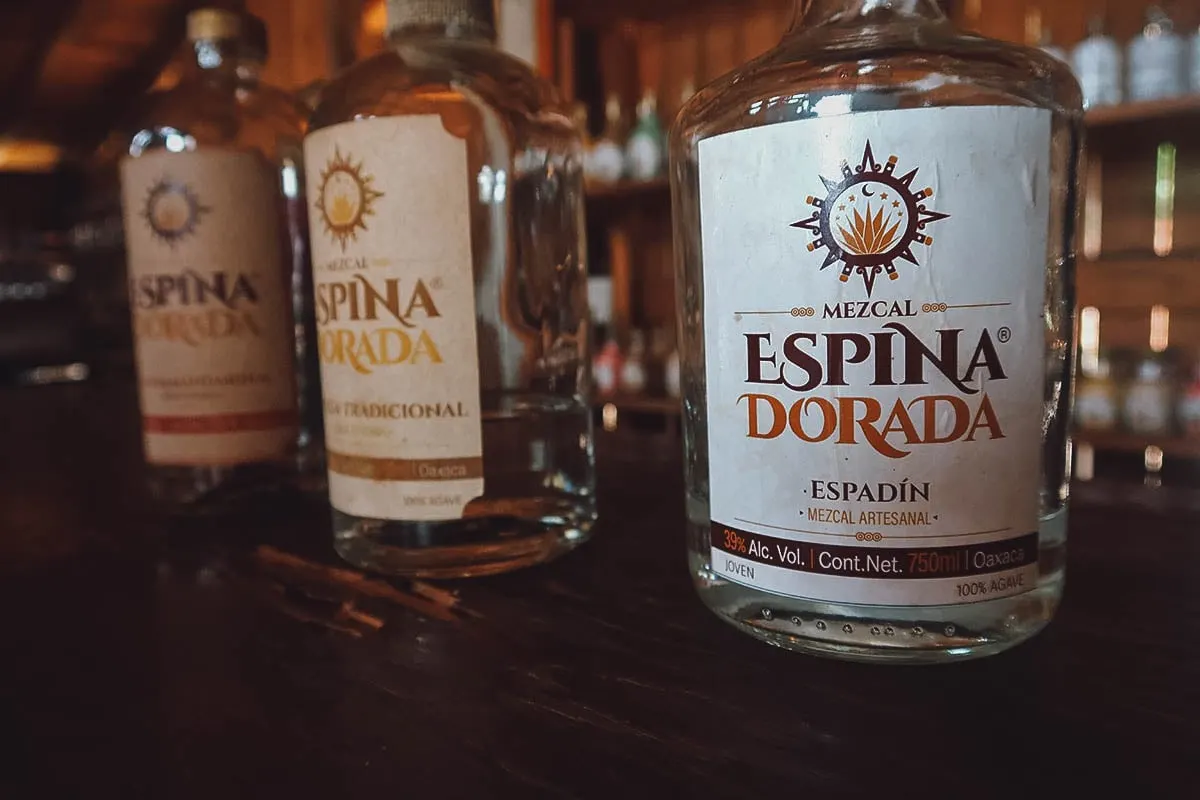
This amber-colored mezcal was the most interesting spirit that we tasted on this mezcal tour. If you look at the bottle’s label, you’ll see that it says “avocado con pechuga de maguey”. Pechuga means “breast” in Spanish and refers to a type of mezcal made with raw chicken breast.
Mezcal de pechuga is a type of spirit that’s made by redistilling finished mezcal with fruits, nuts, and grains. What makes it interesting is that a raw chicken (or turkey) breast is hung over the still during the redistillation process. This cooks the chicken breast in the vapors and is said to influence the mezcal’s final flavor.
From its label, this bottle appears to have been redistilled with avocados as well.
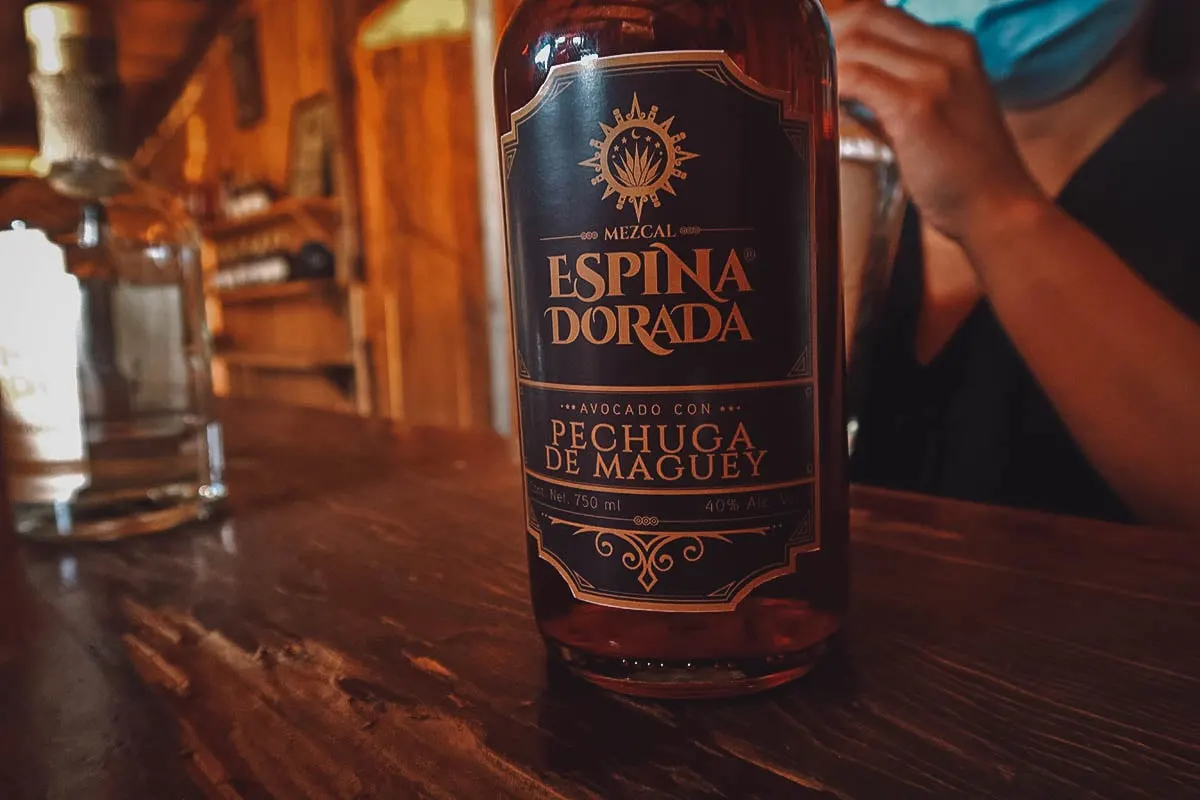
If you’d like to bring home something truly special from this Oaxaca mezcal tour, then a bottle of this pechuga de maguey would make a great souvenir. I didn’t ask how much this particular bottle costs but based on what I’ve read, mezcal de pechuga can fetch over USD 200 a bottle.
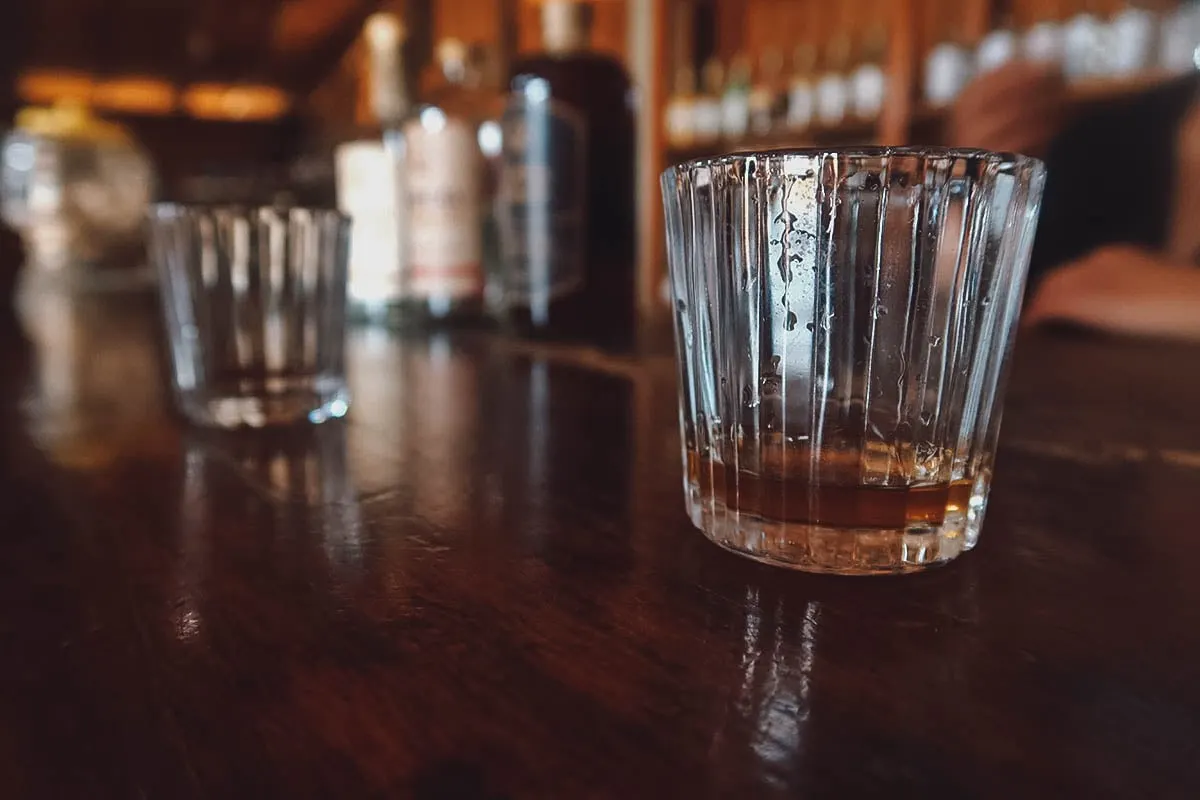
FINAL THOUGHTS ON THIS OAXACA MEZCAL TOUR
With mezcal being an important part of Oaxacan culture, I expected to find more Oaxaca mezcal tours but that wasn’t the case. As described, there are plenty of sightseeing tours that make a quick stop at one or two mezcal distilleries, but mezcal educational excursions don’t seem all that common.
While doing research for this article on the best mezcal tours, I read about another interesting distillery called Gracias a Dios. Located in Santiago Matatlán, they’re known for making an interesting spirit called agave gin.
I love mezcal but my better half is more into gin so a bottle of their agave gin would make a fantastic addition to our bar cabinet. The bottle and label design are terrific as well. Unfortunately, we didn’t learn about Gracias a Dios until now so a visit to this palenque will have to wait until our next trip to Oaxaca.
In any case, I hope you enjoyed reading this article on the Mezcal Adventure tour, which in my opinion, is one of the best mezcal tours you can join in Oaxaca. You can click on the link for more information and to book this mezcal tour on Get Your Guide.
Thanks for reading and salud!
Disclosure
Some of the links in this Oaxaca mezcal tour article are affiliate links, meaning we’ll earn a small commission if you make a purchase at no added cost to you. As always, we only recommend products and services that we use ourselves and firmly believe in. We really appreciate your support as this helps us make more of these free travel guides. Muchas gracias!

